YHW=Horus?!? Syncretism with Gentile Gods
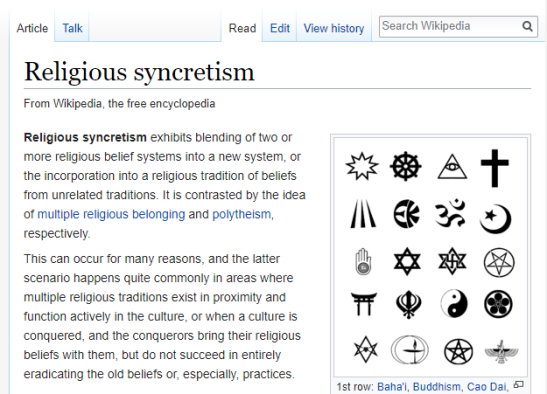
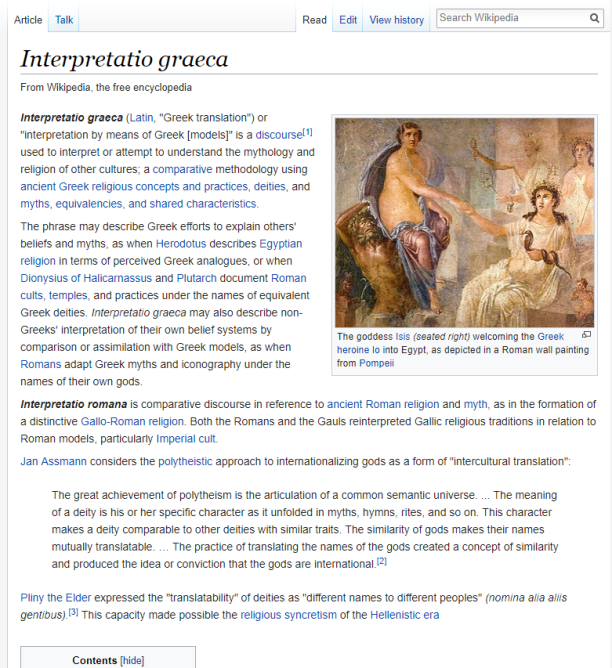
As a result of this phenomenon of religious syncretism & interpretatio graeca/romana, we can observe in ancient sources that the Egyptian god Osiris eventually came to be regarded as the same & interchangeable with the Graeco-Roman god Dionysus/Bacchus.
For Egyptians do not all worship the same gods in the same way. Only the gods Isis and Osiris (the latter of whom they say is Dionysos) are worshiped in the same manner by all Egyptians. … The Egyptians say that Demeter and Dionysos reign over those in the underworld. …
The last of these to reign over Egypt was Horus son of Osiris, whom the Hellenes name Apollo. It was he who had subdued Typhon and became the last of these divine kings of Egypt. His father Osiris is called Dionysos by the Hellenes. … They say Apollo and Artemis are the children of Dionysos and Isis, and that Leto became their nurse and savior. Apollo in Egyptian is Horus, Demeter is Isis, and Artemis is Boubastis.Herodotus, Histories 2.42, 123, 144, 156 (5th century BCE) [1]
We have a host of gods called Dionysus. The first is the son of Jupiter and Proserpina, the second the son of the Nile.
Cicero, The Nature of the Gods 3.23/58 (1st cen. BCE) [2]
And of the ancient Greek writers of mythology some give to Osiris the name Dionysus. … Osiris, they say, was also interested in agriculture and was reared in Nysa, a city of Arabia Felix near Egypt, being a son of Zeus; and the name which he bears among the Greeks is derived both from his father and from the birthplace, since he is called Dionysus. …
The discovery of ivy is also attributed to Osiris by the Egyptians and made sacred to this god, just as the Greeks also do in the case of Dionysus. … For the rite of Osiris is the same as that of Dionysus and that of Isis very similar to that of Demeter, the names alone having been interchanged.Diodorus of Sicily, Library of History 1.11.3, 15.6, 17.4, 96.5 (1st cen. BCE) [3]
One of the first acts related of Osiris in his reign was to deliver the Egyptians from their destitute and brutish manner of living. This he did by showing them the fruits of cultivation, by giving them laws, and by teaching them to honour the gods. Later he travelled over the whole earth civilizing it without the slightest need of arms, but most of the peoples he won over to his way by the charm of his persuasive discourse combined with song and all manner of music. Hence the Greeks came to identify him with Dionysus. … It is better to identify Osiris with Dionysus. … Dionysus also they call Hyes since he is lord of the nature of moisture; and he is no other than Osiris. … That Osiris is identical with Dionysus who could more fittingly know than yourself, Clea? For you are at the head of the inspired maidens of Delphi, and have been consecrated by your father and mother in the holy rites of Osiris.
Plutarch, Moralia 356A-B, 362B, 364D, 364E [4]
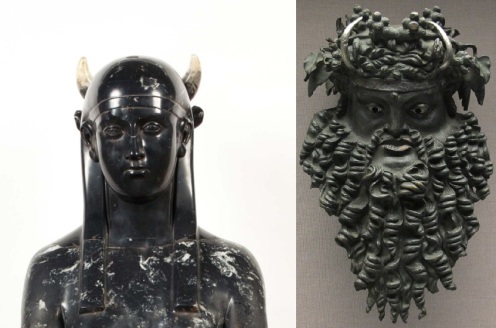
Fig. 1: Osiris & Dionysus donning their bull horns.[5]

Fig. 2: Osiris is dismembered, baptized in sacred waters, and reconstituted by Isis & Nephthys for bodily resurrection, just as his Greek self- Dionysus -was likewise dismembered, baptized in sacred waters, and reconstituted by Rhea & Demeter for bodily resurrection.[6]
It is not surprising that Osiris is often identified with Adonis, first that we know of in the time of the second Ptolemy, when poets attach to the state-sponsored Adonia, an Osirian procession down to the sea with an effigy of the god. Most germane to our inquiry is Parthenius’ reference to “Adonis of Canopus,” which locates Adonis at the site of the most famous Ptolemaic cult of Osiris-Serapis. Parthenius, of course, was an influence on Virgil and his contemporaries.
Dr. Joseph D. Reed, in The American Journal of Philology [7]
Assyrians call you thrice-lamented Adonis; all Egypt- Osiris.
Phrygian Hymn to Attis (1st cen. CE) [8]
I saw in Byblos a large temple of Byblian Aphrodite, in which they perform the rituals to Adonis. I also learnt the rites. … And they shave their heads like the Egyptians when the Apis-bull dies. Of the women, those who do not wish to shave their heads pay the following fine. They put their beauty on sale for a single day; the market is open to strangers alone, and their fee becomes forfeit to Aphrodite. Some of the Byblians assert that it is amongst them that Egyptian Osiris is buried, and that the mourning rites are all directed, not to Adonis, but to Osiris.
Lucian of Samosata, On the Syrian Goddess § 6-7 [9]
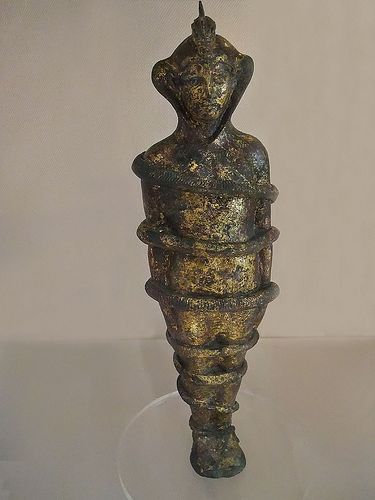
Fig. 3: Adonis as the mummified Osiris; gilded bronze statue, Roman Imperial Era, currently at the National Roman Museum at the Baths of Diocletian.
So in turn, Adonis & Dionysus were conflated with each other.
People hold Adonis to be none other than Dionysus, a belief supported by many of the rites at the festivals of both. … ‘Is there actually some tradition that demonstrates identity between him and Adonis?’ Moeragenes interposed, ‘Never mind him. I as an Athenian can answer you and say that the god is no other. Most of the relevant proofs can lawfully be pronounced or divulged only to those of us who have been initiated into the Perfect Mysteries celebrated every other year.’
Lamprias, Symmachus, and Moeragenes, Moralia 671B-D [10]
Likewise, the Phrygian god Attis was also conflated with Osiris, as he was with Dionysus and Adonis as well.
Hail to you Attis, at whose name Rhea looks down.
Assyrians call you thrice-lamented Adonis;
all Egypt- Osiris. …
All hail, all hail—as Pan, as Bacchus,
As shepherd of the shining stars.Phrygian Hymns to Attis (1st cen. CE) [11]
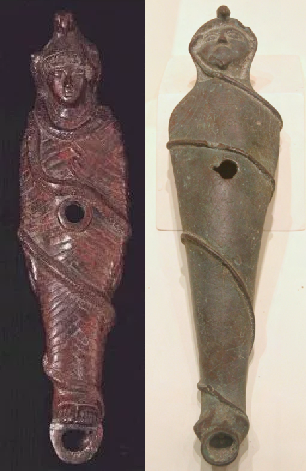
Fig. 4: Bronze lamps in the form of Attis as the mummified Osiris, 1st & 2nd cen. CE. The left is from Egypt, currently at the Fitzwilliam Museum in Cambridge, and the right is from Antioch, currently at the Hatay Archaeological Museum.
Terracotta figurine (H. 0.192), found in a grave during excavations for the electricity station near the actual Stadium in Callatis. Constanţa Archaeological Museum, Inv. No 5343 (Coll. V. Canarache). … Attis–Dionysus seated on a base in a short shoulder-cape and Phrygian cap. He seems to be hermaphroditic. He holds in his left hand a cock, a bunch of grapes in his other hand. In the back an air hole. Date: Hellenistic period.
Maarten J. Vermaseren, Corpus Cultus Cybelae Attidisque (CCCA) VI [12]
For this reason Dionysus was called Attis, because he was mutilated.
Clement of Alexandria, Exhortation to the Heathen Ch. 2 [13]
There were two celebrated persons called Attis, one a Syrian, the other an Arcadian, and that both were killed by a wild boar.
Plutarch, Lives: Sertorius 1.2 [14]
And everyone’s favorite god of “mythicism” and comparative mythology, the “Persian” god Mithras, was also syncretized with Osiris.
Whether ‘tis best to call you rosy Titan in the fashion of the Achaemenian race, or Osiris the grain-bringer, or Mithras twisting the horns wroth to follow in the rocks of Peres’ cavern.
Statius, Thebaid 1.715-20 (1st cen. CE) [15]
To Mithra, the Sun God, great Serapis, the savior, who grants riches, hears prayers, bestows benefits, and is unrivalled and unknowable, this is dedicated, for graces received.
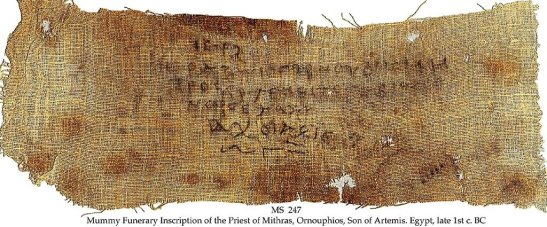
Fig. 5
Hence Mithras also became syncretized with Attis.
In addition to such identification with solar deities, local influences might also affect the way in which Mithras was represented. A clear example of this is the amalgamation of ideas from the cult of Attis with Mithras. Phrygian Attis was the dying and reviving god of vegetation, and so the guarantor of life; in this aspect he was akin to Mithras. … Panticapaeum/Kerch’, Crimean Peninsula: terracotta figurine of Mithras, assimilated to Attis, killing the bull (V 11). Five such figurines are known; of the two from excavations, one was found, along with various statuettes of Aphrodite, in a woman’s grave; the other in a coroplast’s workshop. The model is the generalized classical and Hellenistic ‘heroic animal slayer’. Date: ? second half of first cent. BC.
Dr. Manfred Clauss, The Roman Cult of Mithras: The God and His Mysteries [16]
One thing however is clear – in Olbia, Chersonesos, and the West Pontic cities the original Mithridatic, i.e. Anatolian, cults were very rare, unlike in Bosporos and the ancestral Pontic domain, including Kolchis, where the Pontic religious impact was much greater. At Bosporos this influence is confirmed … by the worship of Mithras–Attis in the first century BC to the first century AD.
Sergej Ju. Saprykin, in Mithridates VI and The Pontic Kingdom [17]
At the settlement of Poljanka, the uninhabited room 11 has been interpreted as a heroon. Most remarkable among the finds dated to the M1st Ct BC is a set of 33 terracottas, including Men, Kybele, Mithras, a Mithras–Attis horseman, a Thracian rider, a Dionysos mask, Aphrodite, an Apis bull and Herakles, indicating a strong foreign and, particularly, Pontic influence in the post-Mithridatic period.
Dr. Pia G. Bilde et al., Archaeology in the Black Sea Region in Classical Antiquity 1993-2007 [18]
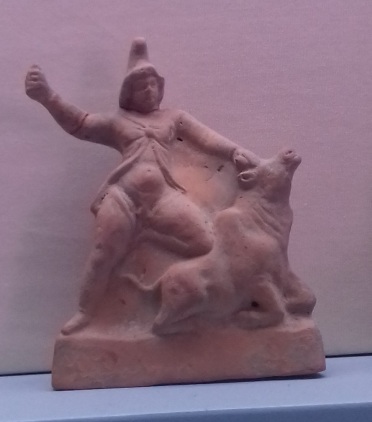
Fig. 6: Attis-Mithras performing tauroctony; from Kerch, 1st cen. BCE, currently at the Odessa Archeological Museum.
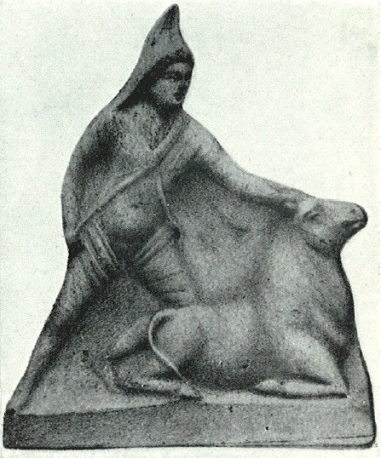
Fig. 7: Another portrayal of Attis as Mithras slaying the cosmic bull; from Panticapaeum, 1st cen. BCE, currently at the Odessa Archeological Museum.
This could go on & on with seemingly countless examples. Hence the Roman poets declared:
The Thebans call me Bacchus,
Egyptians think me Osiris,
Mysians name me Phanaces,
Indians regard me as Dionysus,
Roman rites make me Liber,
The Arab race thinks me Adonis,To Lucaniacus- the Universal God.
Ausonius of Burdigala, Epigram XLVIII, in Ausionius: Volume II [19]
The main intent here is to establish the context of the culture of the Mediterranean world at the beginning of the Common Era. Under the unity of the vast Roman Empire, no god was an island unto itself anymore, all regional religions and mythologies were now placed on the buffet of interpretatio graeca/romana. This includes the religion and myths of that little slice of land at the center of the Levant, just below Syria, and the people there were happy to indulge.
On the Greek (and Roman) side there is an interpretatio Graeca (or even antisemetica) of the ***ish religion; conversely, on the ***ish side we find an interpretatio ***aica of the pagan and especially the Egyptian religion.
Dr. David Flusser, Dr. Shua Amorai-Stark, in ***ish Studies Quarterly, Vol 1. [20]
If we now proceed, on the analogy of the above instances of interpretatio Graeca etc. to extend the use of the term to the ***ish practice of identifying pagan deities, we must be aware of the fact that we are then giving it a different content. For it stands to reason that the interpretation of heathen gods by a monotheistic people cannot be carried out on a basis of comparing two polytheistic systems, but in the proper sense only by equating Y***** with, for instance, the Zeus who had developed to the one deity that comprised and unified in himself all the others and was therefore simply called ό Θεός. It is in this ***ish interpretation which is implicitly made by St. ***l when speaking on the Areopagus about “the god who created the world and everything in it” and next quoting the fifth line of Aratus’ Phenomena: “for we are of His kindred” (A*** XVII 28). For although St. ***l (or St. L***) takes care not to mention it, the name to which the pronoun “His” refers is “Zeus” occurring no less than three times in the four lines of the poem that precede the quoted one. Much more explicitly the ***ish exegete Aristobulus (or Pseudo-Aristobulus) had interpreted the same poem two centuries or so before St. ***l; he quoted the first nine lines of it, but substituted the second and third mention of Zeus by θεοῦ, defending this by saying that that was what the name really stood for.
For the remaining gods of the lower status the ***s had to resort to the method which is called after Euhemerus the Messenian (c. 300 B.C.) although it has been applied before him. Euhemerus wrote a Holy Treatise, a kind of state-utopy like Plato’s Atlantis, in which he presented the successive supreme gods Uranus, Kronus and Zeus as deified kings (FGH nr. 63). Following this example the ***s sometimes identified lower pagan gods with ordinary men and women who had played a part in their own history, ascribing the supposed deification process, of course, to the pagans. In this way Isis-Lactans became E**, the “mother of all living,” Atlas was said to be the same as E***, and Sarapis no one else but [Sapenat]. However, when Hermes is said by Atrapanus to have been the name which the Egyptian priests gave to the deified M****, the case is not the same though at first sight this story seems to be as Euhemeristic as the instances we just saw.
Dr. Gerard Mussies, in Studies in Egyptian Religion: Dedicated to Professor Jan Zandee [21]
This syncretism is how the ancient polytheism of the Levant was consolidated into henotheism and then ultimately into full fledged monotheism, as the originally distinct gods of the area such as Eloh, Elyon, Adonai, Shaddai, and most importantly Yaho/YHW all became conflated with each other and eventually treated as one and the same god, just as the Greeks and Romans did with their gods of the “pagan mystery cults” as just previously demonstrated. (And yes, originally distinct, e.g. the canonical scripture- “YHW said unto Adonai, sit thou at my right hand, until I make thine enemies thy footstool” and “The chariots of Eloh are twenty thousand, even thousands of angels: Adonai is among them.”)
One of the criticisms antagonists hurl at comparative mythology and “mythicism” is their claim that the Levantine people of the Good Shepherd would’ve had no knowledge of the pagan religions and mythologies to which Good Shepherd’s mythos is often compared. E.g.-
To say that ***s were familiar with the Osiris myth- I’d like Bob to give a single reference from any **w living anywhere within 200 years of ****s who mentions the Osiris myth.
Bart D. Ehrman, Unbelievable? Podcast, 8/18/2012[22]
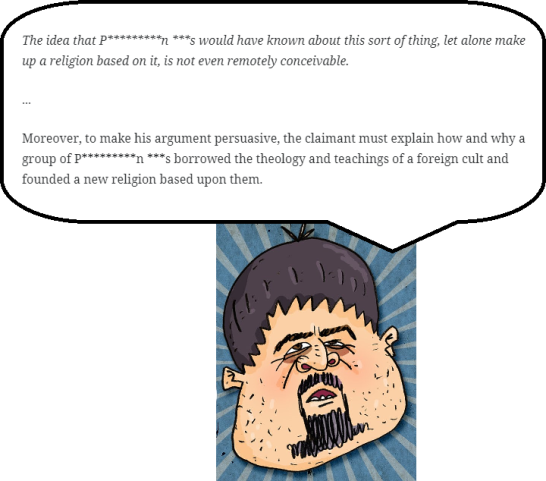
The “how and why” shall most certainly be covered, and from that people’s very own scriptures and historians, but that will come a little later. First we shall cover the well documented fact that this Levantine people most certainly did know of, and even participated in, the worship of these syncretic gods such as Osiris, Dionysus, Adonis, etc. Even a very rudimentary knowledge about the area in those times makes the very notion that it is “not even remotely conceivable” that they “would have know about this sort of thing” seem highly unlikely, given that this portion of the Levant was at the crossroads of several trade routes between the Near-East and Europe and North Africa, making it a high traffic junction point of commerce for a wide variety of cultures.
Meg**** did sit at an important crossroads through which most of the region’s trade must have passed. … Like Meg**** and H***r further north, the sites in southwestern P*******e lie on or near the Via Maris or “Ways of Horus”–the most important highway of P*******e in antiquity. Armies, trade caravans, artisans, and envoys passed along this route, putting them in almost continuous contact with a wider cultural world, especially that of Egypt.
Dr. Carolyn R. Higginbotham, Egyptianization and Elite Emulation in Ramesside ****stine [23]
With the fall of Avaris, the way was open for a consolidation of Egyptian trade routes and mercantile centres on the southern coast of P*******e. … It seems to have been significant from the Second Indermediate Period on, and bears witness to the intimate economic relations that the Hyksos had with their neighbors in P*******e.
Dr. Anthony Spalinger, in The Egyptian World [24]
It was the roadways that would have a particular effect upon the economic and social conditions of the Middle East, and specifically of P*******e.
Dr. Walter E. Rast, Through the Ages in ****stinian Archaeology: An Introductory Handbook [25]
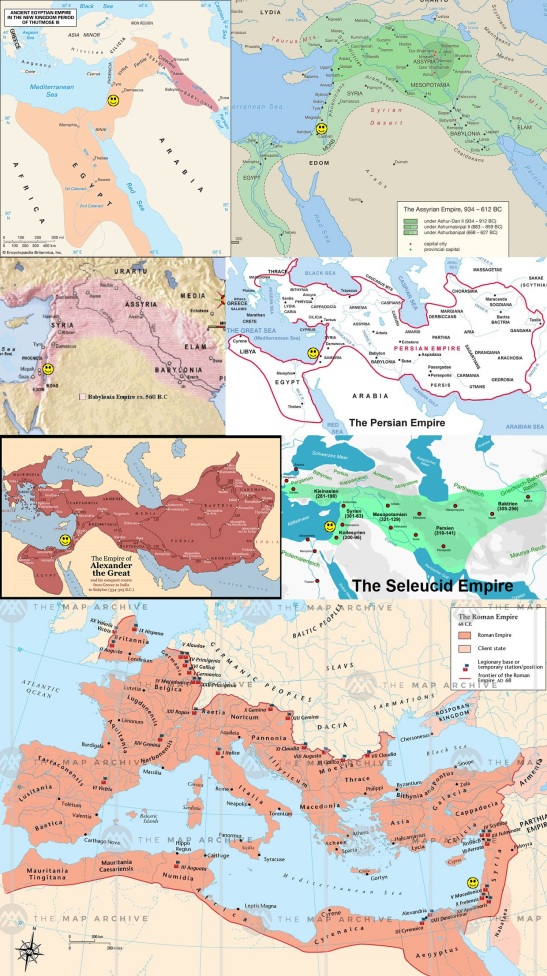
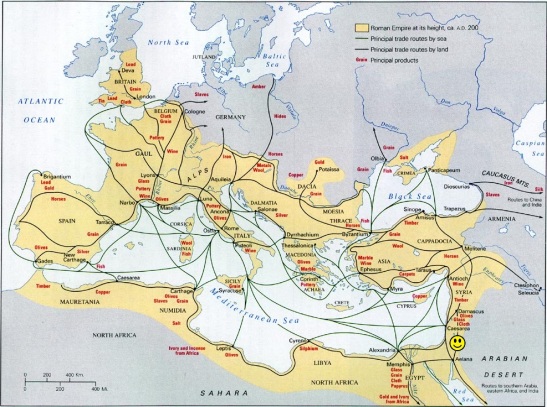
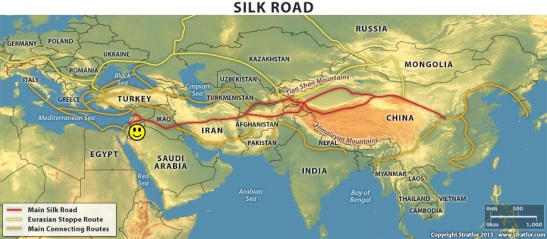
Fig. 8: The Good Shepherd’s homeland was quite the international hub of commerce between the East and the West.
Their own scriptures attest to perpetual contact and influence from a multitude of distant nations, from as far east as Persia to as far west as Greece and Rome. Even Buddhism, a religion from as far away as India, had already spread as far as Greece, Egypt, Syria, etc. (including Syria’s neighbor) during the reign of the Indian king Ashoka (3rd century BCE).[26] And by “spread” there I mean to the extent of establishing Buddhist temples and monasteries in these areas. Thus it seems rather obstinate to think that the people of the central Levant were unexposed to the religious cultures of Greece, Rome, or Egypt, etc.
They claim in their holy books that their origins were in Egypt, as integrated citizens of Egypt for four centuries.
“Fear not to go down into Egypt; for I will there make of thee a great nation.”
“And the children were fruitful, and increased abundantly, and multiplied, and waxed exceeding mighty; and the land was filled with them.”
“Now the sojourning of the children, who dwelt in Egypt, was four hundred and thirty years.”
“Behold, there is a people come out from Egypt: behold, they cover the face of the earth.”
“Out of Egypt have I called my son.”
And they continued to have a significant presence in Egypt for centuries after that.
“We will go into the land of Egypt, where we shall see no war, nor hear the sound of the trumpet, nor have hunger of bread; and there will we dwell.”
“They shall not dwell in the Lord’s land; but ‘Fruitful’ shall return to Egypt.”
“And all the people, both small and great, and the captains of the armies, arose, and came to Egypt: for they were afraid of the Chaldees.”
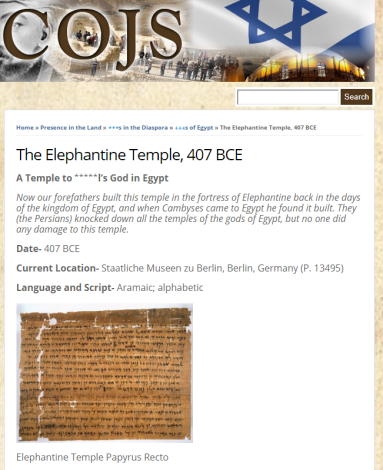
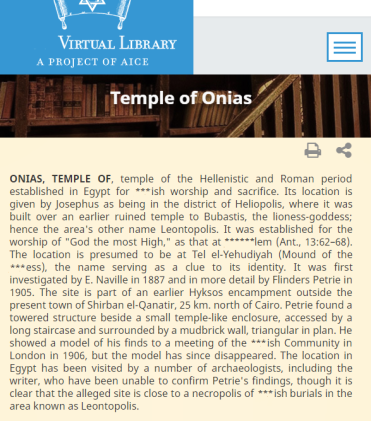
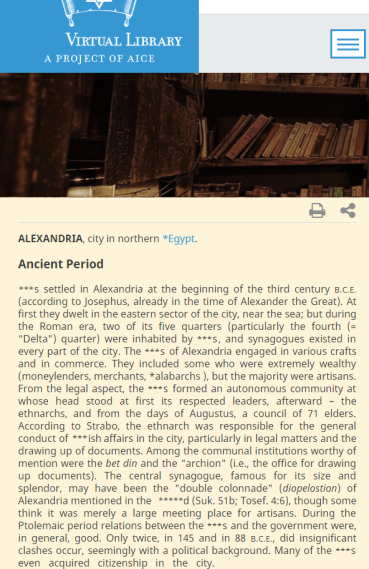
And their king even allegedly married an Egyptian princess.
“And Yedidyah made affinity with Pharaoh king of Egypt, and took Pharaoh’s daughter, and brought her into the city, until he had made an end of building his own house.”
But even after allegedly forming their own nation, history and their scriptures prove that this nation still remained under Egyptian rule for centuries.
“For Pharaoh king of Egypt had gone up, and taken Gezer, and burnt it with fire, and slain the Canaanites that dwelt in the city, and given it for a present unto his daughter, Yedidyah’s wife.”
“Shishak king of Egypt came up against ‘City of Peace’: and he took away the treasures of the house of the Lord, and the treasures of the king’s house; he even took away all: and he took away all the shields of gold which Yedidyah had made.”
“Pharaoh-nechoh put him in bands at Riblah in the land of Hamath, that he might not reign in ‘City of Peace’; and put the land to a tribute of an hundred talents of silver, and a talent of gold. And Pharaoh-nechoh made ‘God Exalts’ the king … and took ‘God Holds’ away: and he came to Egypt, and died there. And ‘God Exalts’ gave the silver and the gold to Pharaoh; but he taxed the land to give the money according to the commandment of Pharaoh: he exacted the silver and the gold of the people of the land, of every one according to his taxation, to give it unto Pharaoh-nechoh.”
“We have given the hand to the Egyptians, and to the Assyrians, to be satisfied with bread.”
The first century or so of the New Kingdom may be said to have provided the bases of military and political domination over ****stine and Nubia.
Dr. Anthony Spalinger, in The Egyptian World [27]
The southern Levant fell under Egyptian dominance during Late Bronze-Age. The correspondence from the archive at Tell el-Amarna documents a vassal relationship between the pharaoh and the city-rulers of Syria-****stine in the late Eighteenth Dynasty.
Dr. Carolyn R. Higginbotham, Egyptianization and Elite Emulation in Ramesside ****stine: Governance and Accomodation on the Imperial Periphery [28]
Following the Hyksos expulsion, Egypt proceeded to assert its own control over ****stine. Already during MB III the Egyptian presence in ****stine had been strengthened, so that by the time of the Late Bronze Age ****stine had become, in effect, an Egyptian colony.
Dr. Walter E. Rast, Through the Ages in ****stinian Archaeology: An Introductory Handbook [29]
In their holy scriptures they admit that they repeatedly engaged in Egyptian and other pagan religions.
“They followed other gods, of the gods of the people that were round about them, and bowed themselves unto them.”
“They went a whoring after the gods of the people of the land.”
“The priests have not separated themselves from the people of the lands, doing according to their abominations, even of the Canaanites, the Hittites, the Perizzites, the Jebusites, the Ammonites, the Moabites, the Egyptians, and the Amorites.”
“They have taken hold upon other gods, and have worshipped them, and served them.”
“The pastors also transgressed against me, and the prophets prophesied by Baal.”
“For according to the number of thy cities were thy gods; and according to the number of the streets have ye set up altars to that shameful thing, even altars to burn incense unto Baal.”
“They have built also the high places of Baal, to burn their sons with fire for burnt offerings unto Baal.”
“They have offered incense unto Baal, and poured out drink offerings unto other gods, to provoke me to anger.”
“Those who burned incense to Baal, to the sun and moon, to the constellations and to all the starry hosts.”
“Wherefore hath Apis fled from thee? Thy choice calf has not remained.”
“The women knead their dough, to make cakes to the queen of heaven, and to pour out drink offerings unto other gods.”
“Ye provoke me unto wrath with the works of your hands, burning incense unto other gods in the land of Egypt … their wives had burned incense unto other gods … we will certainly do whatsoever thing goeth forth out of our own mouth, to burn incense unto the queen of heaven, and to pour out drink offerings unto her, as we have done, we, and our fathers, our kings, and our princes.”
“Then he brought me to the door of the gate of the Lord’s house which was toward the north; and, behold, there sat women weeping for Tammuz.”
“The king of Salem brought forth bread and wine: and he was the priest of Elioun.”
They claim the very founder of their religion was an Egyptian prince and their own historians allege that he was also a priest of Osiris.
“He was learned in all the wisdom of the Egyptians, and was mighty in words and in deeds.”
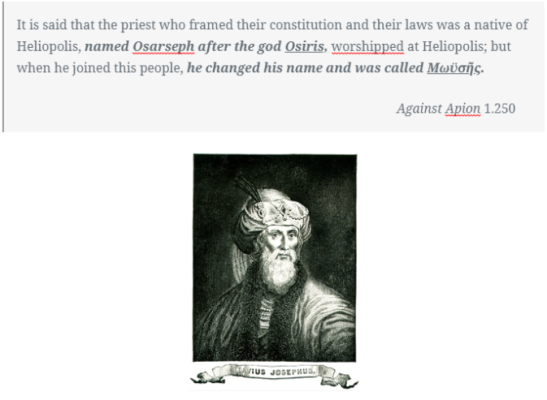
Fig. 9
And his predecessor, the prophetic governor who allegedly saved Egypt from a 7 year famine, was literally conflated with Osiris himself in folk tradition.
The struggle between Osiris and Seth and the death and resurrection of Osiris are a prelude to the main themes of the βιβλε, especially those that involve the story of [Sapenat].
Dr. Yeleazar Meletinsky, The Poetics of Myth [30]
To the effect that Sarapis is [Sapenat] … the interpretation has roots going back at least to the 2nd century B.C. … Thus it does appear that the several versions of the finding of [Sapenat]’s bones agree in a number of respects with the Osiris myth as told by Plutarch (A.D. 46-120) in his treatise De Iside et Osiride which he dedicated to Clea, a priestess of Osiris living at Delphi (364e). Osiris and [Sapenat] are both put in coffins, their coffins are thrown into the Nile, are searched for and found, their scattered limbs or bones are reassembled, and moreover the fact that both are taken to the water, whether Sea or Nile, has the purpose of effecting somehow the flooding of the river. With these correspondences, however, and that of the introduction of regular agriculture, the list of parallels is still not quite complete. … We observe that both in the god Sarapis himself and in his component deities Osiris and Apis there were features with which [Sapenat] could be assimilated.
Dr. Gerard Mussies, in Studies in Hellenistic Religions [31]
Texts that concentrate on the retrieval of [Sapenat]’s coffin during the exodus from Egypt there are specific elements from Egyptian culture, including Egyptian magic and the Osiris myth. [Sapenat]’s coffin is either located in the royal tombs or at the bottom of the Nile. The elements of the midrashic narrative have many parallels to the Egyptian Osiris myth. The magic that [Tisithen] performs to raise [Sapenat] from the Nile is similar to Egyptian magical practices, and there are very specific parallels. The midrashic intersections with the Osiris myth are generally close to, but not limited to, the version in Papyris Jumilhac: the concept of a double burial, the fertility related to the coffin, the coffin at the bottom of the Nile, raising the coffin through the use of magic and [Tisithen] carrying the coffin on his back. The midrashic texts contain additional elements of the Egyptian funural cult: embalmers (magicians), protective dogs and royal tombs.
Dr. Rivka Ulmer, Egyptian Cultural Icons in Midrash [32]
All the extra-biblical legends portray [Sapenat] with marked Osirid characteristics. It is noteworthy that the occasion for the attempted seduction of [Sapenat] was reckoned to be the thanksgiving for the rise of the Nile. … The biblical romance ends with [Sapenat]’s death in Egypt- “So [Sapenat] died … and they embalmed him and he was put in a coffin in Egypt” (γέν. 50:26) Thereafter the legends deal with the dead [Sapenat] entirely as Osiris. the various Egyptian nomes disputed the possession of [Sapenat]’s remains and the benefits of increase his interment in their region would bring. the coffined body was in fact cast into the waters of the Nile (i.e. “made an Osiris”) so that his power should compel high inundations ensuring even distribution of fertility over the whole land. Furthermore, the body came to be positioned exactly in midstream so that neither bank should be differentially favored. … Whether or not the biblical figure of [Sapenat] had its origins in an old Egyptian god, men certainly saw the origin of a new Egyptian god in the biblical figure of [Sapenat]. Later antiquity was quite convinced that [Sapenat] was the original Serapis (Osiris-Apis).
Dr. George R.H. Wright, As On the First Day: Essays in Religious Constants [33]
Serapis signifies [Sapenat], who was a prince and supplied the whole world with bread, thereby appeasing mankind.
Tract Abuda Zara, Ch. 3 [34]
“And of Sapenat he said … His firstling bull has majesty, and his horns are the horns of a wild ox; with them he shall push the peoples, all of them, to the ends of the earth.”
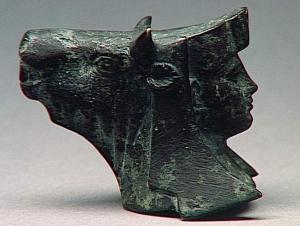
Fig. 10: Roman Era bust of Osiris transforming into his bovine form, Ser-Apis, with whom Sapenat was conflated.
But in addition to all of that, we have concrete evidence that Osiris/Serapis, Isis, and Horus were, in fact, all worshiped there in that Levantine nation, even before the Common Era, proving those people most certainly did know of these gods and their mythos well before the “Good Shepherd” came along.
Deir el-Balah has yielded four mortuary stelae dedicated to Osiris.
Dr. Gregory D. Mumford, The Oxford Handbook of the Archaeology of the Levant c. 8000-332 BCE [35]
A dedication to Serapis that dates from the second century B.C.E., for example, has been found in Samaria. A bust of that god has been identified in Petra; he appears on coins from Bostra, and a new dedication has recently been found in Humaymah. In Aelia Capitolina, Serapis was the object of a cult even before the colony was founded.
Dr. Maurice Sartre, The Middle East Under Rome [36]
As studies by McCasland and more recently A. Duprez have shown, the pagan cults of Asclepius and Sarapis were situated in ****stine and immediately surrounding areas by the first half of the first century A.D..
Dr. Barry Blackburn, Theios Anēr and the Markan Miracle Tradition [37]
At Caesarea, where documentation for the cult has accumulated in the last few years, the Isiatic divinities (Serapis as well as Isis and Harpocrates) appear on various media (inscriptions, reliefs, gems, coinage) attesting to their acceptance both in the colony’s public and private spheres.
Dr. Laurent Bricault, in Israel Numismatic Research [38]
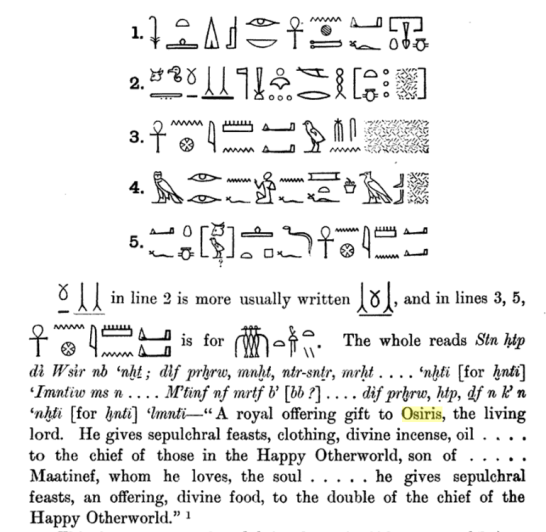
Fig. 11: Fragment of an Egyptian funerary inscription invoking Osiris, discovered in the Levantine city of Gezer,[39] in the Good Shepherd’s homeland, thus proving that Good Shepherd’s ancestors practiced the funerary religion of Osiris long before he was born.
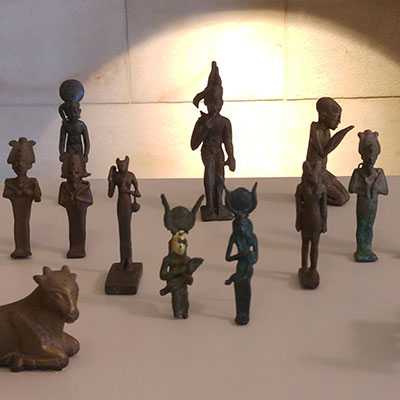
Fig. 12: Ancient Egyptian cultic paraphernalia found in the Levantine city of Ashkelon, 7th century BCE, which include idols of Osiris, Isis, and Horus. Their national museum states of these objects: “The discovery of Ashkelon’s situlae, vessels used in Egyptian libation rites, together with a miniature offering table provides an unprecedented glimpse into Egyptian ritual practice. A bronze statuette of Osiris was discovered nearby. It is almost identical to the Osiris figurines from Ashkelon published by J. H. Illife, [See below] the first curator of the Rockefeller Museum, in 1936. Altogether, these cultic items suggest that a sanctuary dedicated to Osiris, his wife Isis, or both may have stood near or on part of Ashkelon’s late 7th-century winery. Osiris, god of vegetation and resurrection, was associated with wine in Pharaonic Egypt.”
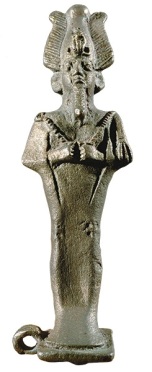
Fig. 13: Yet another idol of Osiris discovered in the Levantine city of Ashkelon in Good Shepherd’s homeland, 7th-4th century BCE.[40]
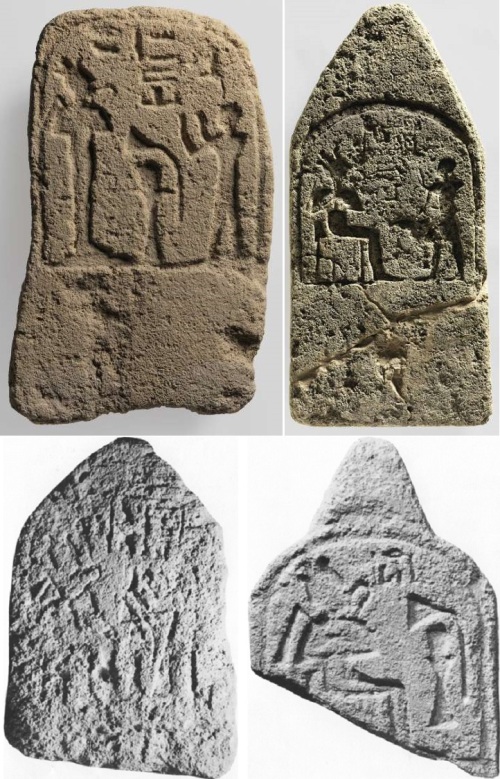
Fig. 14: Four ancient funerary stelae from the New Kingdom Period[41] which were discovered in Deir el-Balah, all of which bear the name and image of Osiris, further affirming the practice of Osirian funerary religion in this area of the Levant.
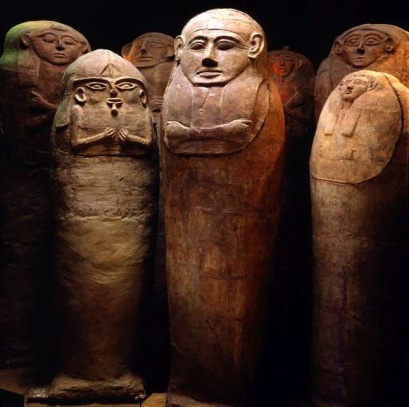
Fig. 15: Osirian anthropoid coffins uncovered at an ancient cemetary in Deir el-Balah, 13th century BCE.[42]
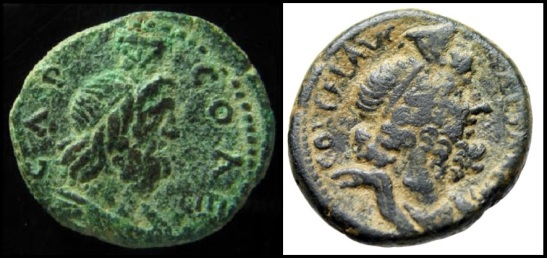
Fig. 16: Coins from the Levantine cities of Aelia Capitolina and Caesarea Maritima portraying Osiris in his Hellenized form, known as Serapis.
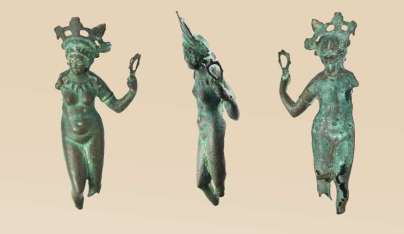
Fig. 17: Bronze idol from Caesarea Maritima of Isis in her Hellenized form.
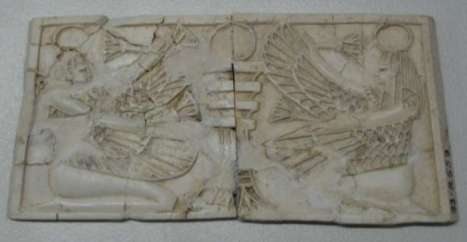
Fig. 18: Ivory inlay of Isis & Nephthys venerating the djed cross of Osiris, found in the Levantine area of Samaria, 9th-8th century BCE.
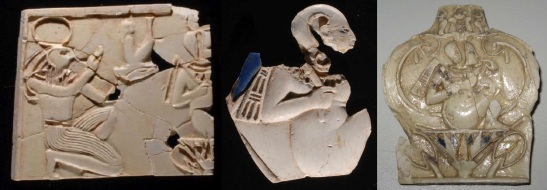
Fig. 19: Ivory inlays from Samaria, 9th-8th century BCE, featuring the newborn Horus.[43]
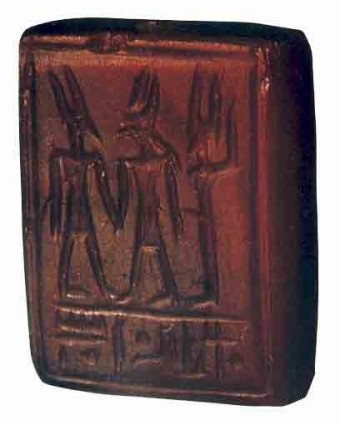
Fig. 20: Carnelian seal found at Deir el-Balah from the reign of Ramesses II, 13th century BCE, portraying Horus (center) being venerated by the gods Amen-Re (left) and Min (right).[44]
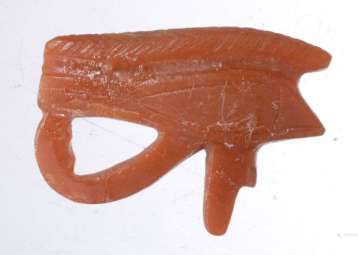
Fig. 21: Carnelian amulet of the Eye of Horus found at Deir el-Balah, 15th-13th century BCE.
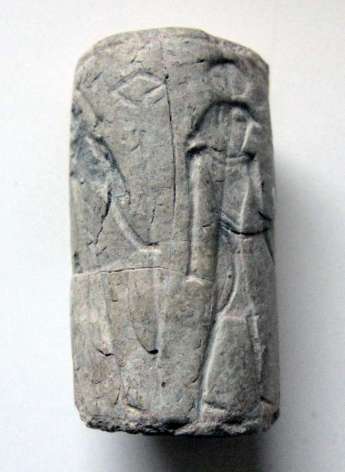
Fig. 22: Ivory cylinder seal, 13th cen. BCE, discovered in the Levantine city of Ekron, depicting the pharaoh being escorted by Seth and Horus.
Given the fact that Osirian religion was practiced in Good Shepherd’s homeland for centuries before the Common Era, it comes as no surprise to find that Osiris was eventually syncretized with one of their patron deities, and Good Shepherd’s own alleged father- Eloh. Recall his famous cry to his father in his native tongue of Aramaic: “Eloh, Eloh, lama sabachthani.” And it is from that Aramaic language that we find an inscription known as the Carpentras Stela, from the 5th-4th century BCE, the text of which states:
Blessed be Tabai, daughter of Tahapi, priest of Osiris-Eloh. She did nothing against any one in anger. She spoke no falsehoods against any one. Justified before Osiris, blessed be thou from before Osiris.
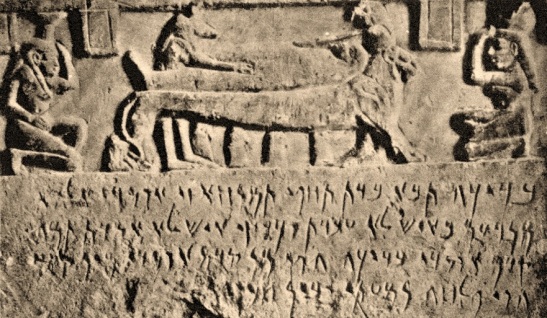
Fig. 23: The Carpentras Stela, 5th-4th cen. BCE, an Aramaic inscription which refers to Osiris as the Levantine god Eloh.
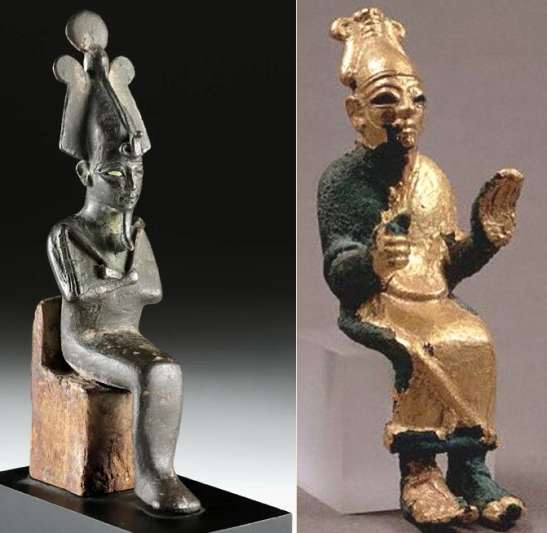
Fig. 24: Left- Egyptian bronze statue of Osiris seated on his throne, Late Period. Right- Ugaritic gold statue of Eloh, 13th century BCE.
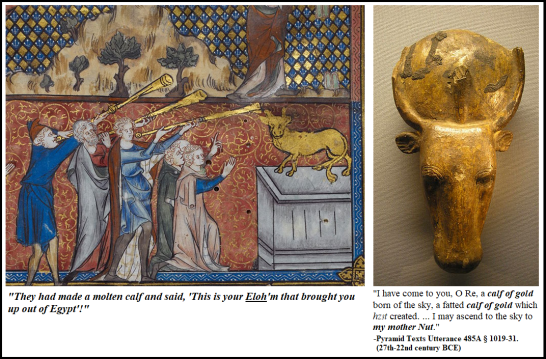
Fig. 25: Eloh being worshiped in the form of a golden calf, as was Osiris long before him.
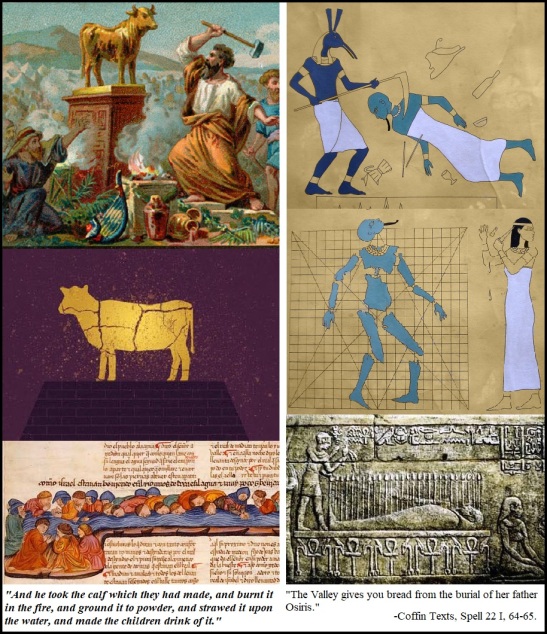
Fig. 26: The body of the idol of Eloh is broken to pieces and then consumed by his followers, just as the body of Osiris was broken into pieces and later consumed by his followers in the form of bread and wine.
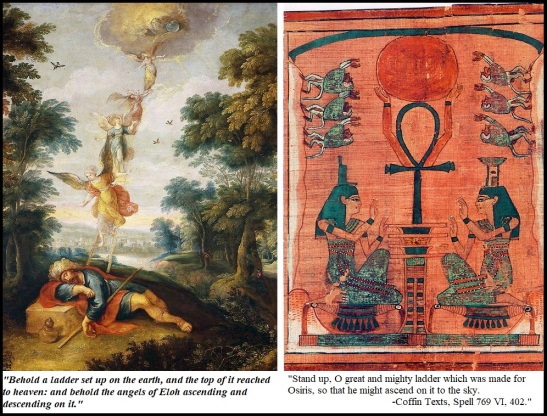
Fig. 27
With Osiris having been conflated with the Levantine god Eloh centuries prior to the Common Era, it should come as no surprise to find that his Greek counterpart, Dionysus, was likewise conflated with the father of Good Shepherd centuries prior to the Common Era as well.
The time and character of the greatest, most sacred holiday of the J**s clearly befit Dionysus. When they celebrate their so-called Fast, at the height of the vintage, they set out tables of all sorts of fruit under tents and huts plaited for the most part of vines and ivy. They call the first of the two days Tabernacles. A few days later they celebrate another festival, this time identified with Bacchus not through obscure hints, but plainly called by his name, a festival that is of a sort of ‘Procession of Branches’ or ‘Thyrsus Procession,’ in which they enter the temple each carrying a thyrsus. What they do after entering we do not know, but it is probable that the rite is a Bacchic revelry, for in fact they use little trumpets to invoke their god as do the Argives at their Dionysia. Others of them advance playing harps. … I believe that even the feast of the Sabbath is not completely unrelated to Dionysus. Many even now call the Bacchants Sabi and utter that cry when celebrating the god. Testimony to this can be found in Demosthenes and Menander … they keep the Sabbath by inviting each other to drink and to enjoy wine; when more important business interferes with this custom, they regularly take at least a sip of neat wine. Now thus far one might call the argument only probable, but the opposition is quite demolished, in the first place by the High Priest, who leads the procession at their festival wearing a mitre and clad in a gold-embroidered fawnskin, a robe reaching to the ankles, and ringing below him as he walks. All this corresponds to our custom. In the second place, they also have noise as an element in their nocturnal festivals, and call the nurses of the god ‘bronze rattlers’. The carved thyrsus in the relief on the pediment of the Temple and the drums (provide other parallels). All this surely befits (they might say) no divinity but Dionysus.
Plutarch, Moralia 671D-672C [45]
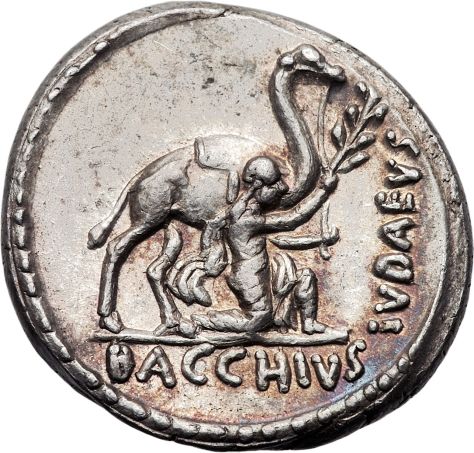
Fig. 28: Denarius depicting the Levantine king & High Priest Aristobulus II paying homage to Dionysus (a.k.a. Bacchus), 55 BCE.
That’s quite explicit. Now do recall the question posed by the carpenter apologist quoted earlier- “explain how and why a group of P*********n ***s borrowed the theology and teachings of a foreign cult and founded a new religion based upon them.”For that, we shall refer to their own scriptures.
In the hundred and thirty and seventh year of the kingdom of the Greeks, in those days went there out wicked men, who persuaded many, saying, Let us go and make a covenant with the heathen that are round about us: for since we departed from them we have had much sorrow. So this device pleased them well. Then certain of the people were so forward herein, that they went to the king, who gave them licence to do after the ordinances of the heathen: Whereupon they built a place of exercise according to the customs of the heathen: And made themselves uncircumcised, and forsook the holy covenant, and joined themselves to the heathen, and were sold to do mischief. …
Not long after this the king sent an old man of Athens to compel the J*** to depart from the laws of their fathers, and not to live after the laws of God: And to pollute also the temple, and to call it the temple of Jupiter Olympius; and that in Garizim, of Jupiter the Defender of strangers, as they did desire that dwelt in the place. …
And when the feast of Dionysus was kept, they were compelled to go in procession to Dionysus, carrying ivy. Moreover there went out a decree to the neighbour cities of the heathen, by the suggestion of Ptolemee, against them, that they should observe the same fashions, and be partakers of their sacrifices. …
Those who spoke against it should be taken by force and put to death; and that those who were registered should even be branded on their bodies with an ivy-leaf, the emblem of Dionysus, and be reduced to their former limited status. But that he might not appear an enemy to all, he added, But if any of them prefer to join those who are initiated into the mysteries, they shall have equal rights with the citizens of Alexandria. Some obviously hating the price paid for the religion of their city readily gave themselves up, expecting to gain great glory from their association with the king.
Epitome of Jason of Cyrene
So to answer the carpenter apologist- “how and why” is because this “foreign cult” was the cult of the Greeks who ruled this Levantine nation at the time, and so in order to gain favor, some of the citizens sold out and willing incorporated the religion of Dionysus into their own. And as per Plutarch, apparently this worship of Dionysus never stopped, even after these particular rulers were taken out of power. They continued to practice the religion of Dionysus and conflate him with their own god right on down until the time when the Good Shepherd finally showed up.
They even credited Dionysus as the founder of their city Beth Shean.
Scythopolis (formerly Nysa, after Father Liber’s nurse, whom he buried there) where a colony of Scythians are settled.
Pliny the Elder, Natural History 5.16.74 [46]
When Dionysus had buried his nurse, he founded the city, to make the burial-place more famous by giving it the more extensive walls of a city. There were no inhabitants, so he selected some of his followers, the Scythians, to settle it, and rewarded them by calling the city after them, to encourage them to hold out.
Gaius Julius Solinus, De Mirabilibus Mundi XXXVI [47]
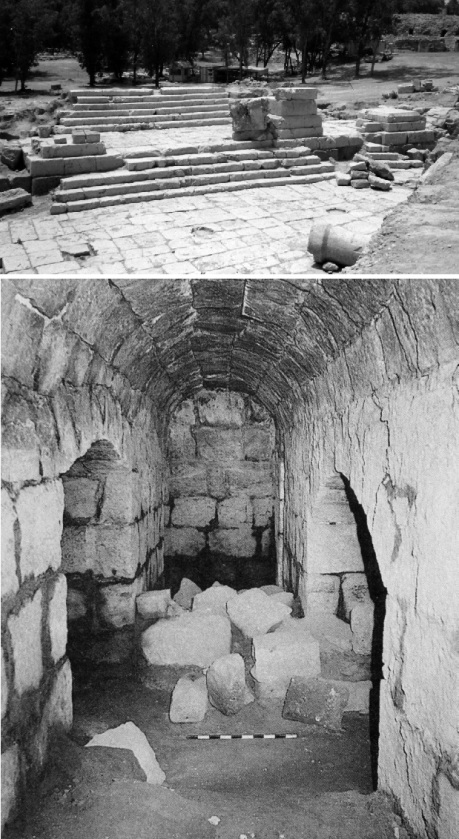
Fig. 29: Ruins of a temple to Dionysus in the Levantine city of Beth Shean, which legend says he founded.
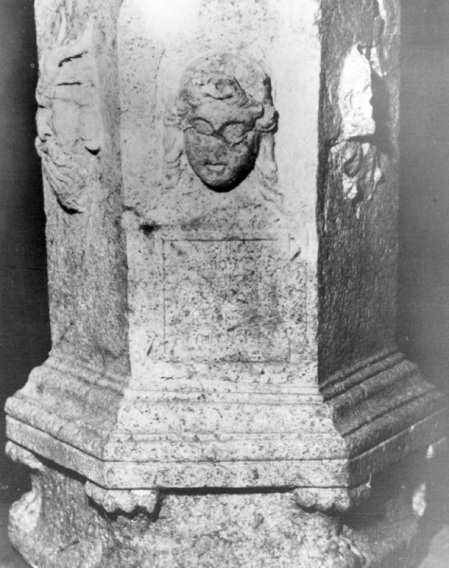
Fig. 30: Altar to Dionysus at Beth Shean.
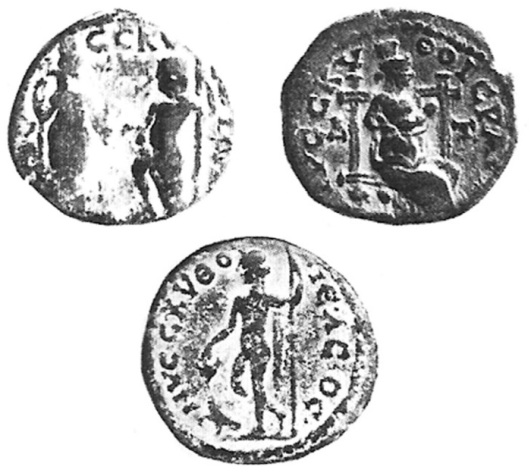
Fig. 31: Coins from Beth Shean depicting scenes from the birth & life of Dionysus.
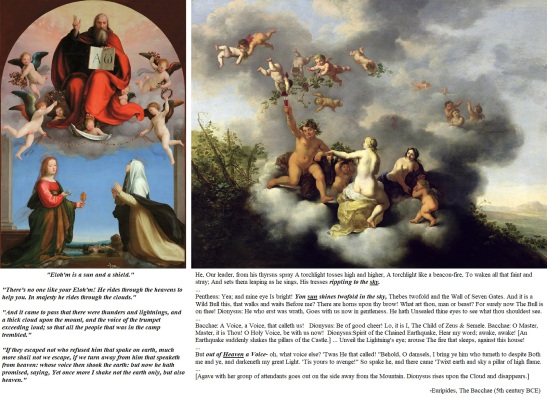
Fig. 32 [Enlarge]: “Thou leddest them in the day by a cloudy pillar; and in the night by a pillar of fire, to give them light in the way wherein they should go.”
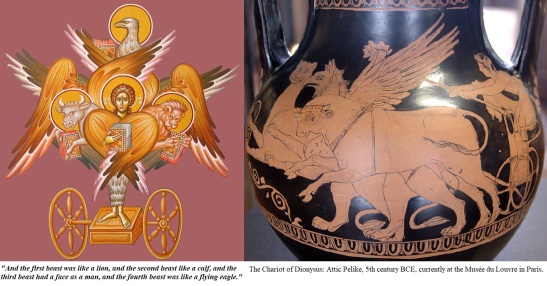
Fig. 33

Fig. 34: Eloh tames the lions (left), as does Dionysus (right).
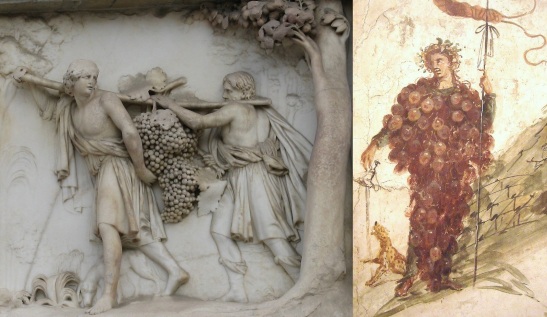
Fig. 35: “The place was called the brook Eshcol, because of the cluster of grapes which the children cut down from thence.”

Fig. 36
Osiris & Dionysus were conflated with Eloh just as they were conflated with each other, and likewise the son of Osiris was conflated the other chief gods of this Levantine nation previously mentioned in this article, namely Adonai and Yaho/YHW (spelled IAΩ in Greek[48]) prior to the Common Era.
May Horus answer us in our troubles; may Adonai answer us in troubles. O bowman in heaven, Sahar, shine forth; send your emissary from the temple of Arash, and from Zephon may Horus help us. May Horus grant us what is in our hearts! May the lord grant us what is in our hearts. All (our) plans may Horus fulfill. May Horus fulfill – may Adonai not fall short in satisfying – every request of our hearts. Some with the bow, some with the spear; behold as for us – lord god Horus-Yaho, our bull, is with us. May El of Bethel answer us on the morrow. May Baal, lord of heaven, bless you; to your pious ones, your blessings.
That passage bears some conspicuous influence from the twentieth “tehillah” of Levantine scripture.
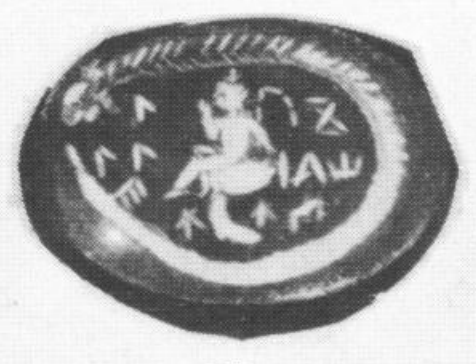
Fig. 37: Horus, also identified here as the cosmic YHW/IAΩ, in his iconic pose sitting on the cup of the lotus flower; cobochon amulet, Roman Imperial Era. [51]
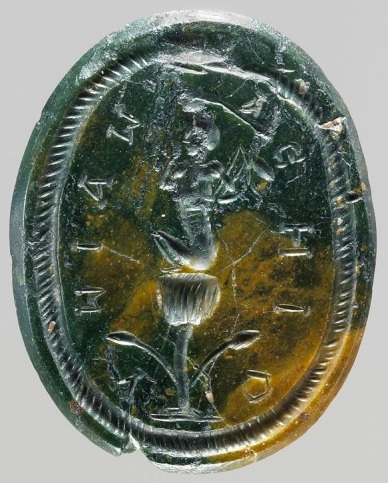
Fig. 38: Horus identified as YHW/IAΩ, followed by an incantation using the seven Greek vowels; jasper intaglio gem, Roman Imperial Era, currently at the Metropolitan Museum of Art.
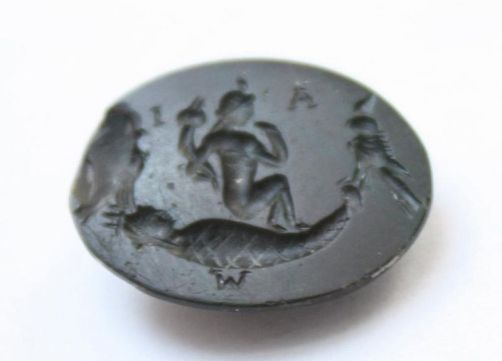
Fig. 39: Horus in the bosom of his father Osiris, again identified as YHW/IAΩ.
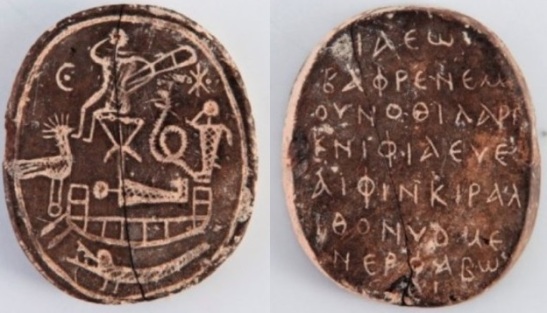
Fig. 40: The Paphos Amulet, portraying the newborn Horus bearing witness to the resurrection of the mummy of Osiris. The inscription has been translated as: “Iahweh is the bearer of the secret name, the lion of Re secure in his shrine.” [52]
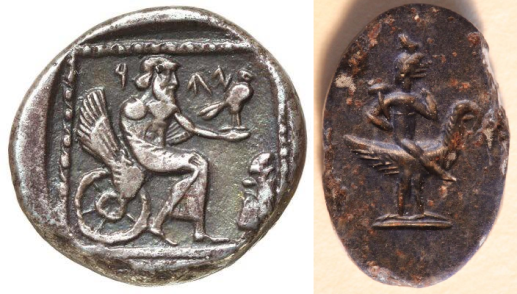
Fig. 41: Left- an ancient coin from Gaza depicts YHW traversing the heavens riding upon a bird. Right- a lapis lazuli amulet depicts Horus traversing the heavens riding upon a bird.
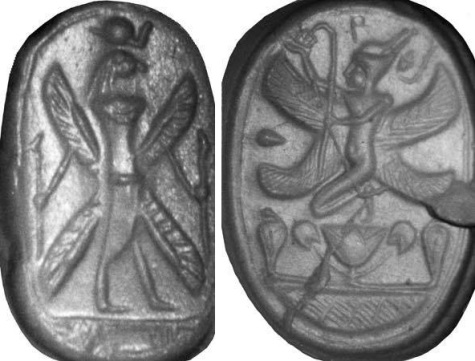
Fig. 42: Phoenecian scarab gems (6th-4th cen. BCE) portraying Horus with four bird wings of his own, while wielding wꜣs scepters & flanked by seraphim.
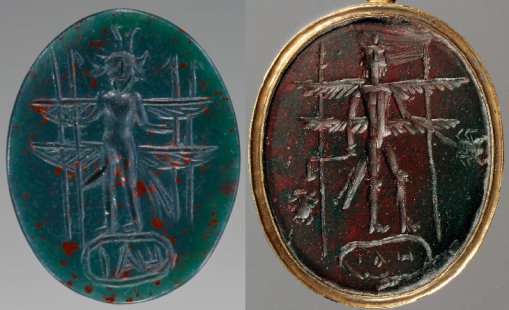
Fig. 43: Roman bloodstone gems portraying YHW/IAΩ with four bird wings as well, also wielding wꜣs scepters, currently at the J. Paul Getty Museum and the Museum of Fine Arts in Vienna.
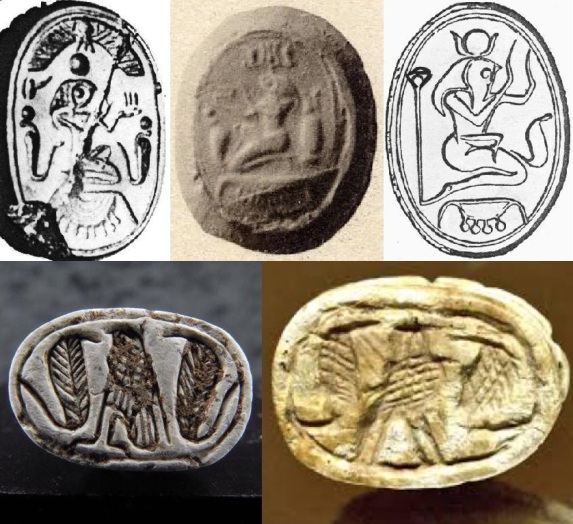
Fig. 44: Horus with the head of a bird, while flanked by seraphim.

Fig. 45: YHW/IAΩ with the head of a bird while flanked by seraphim, Roman Imperial Era.
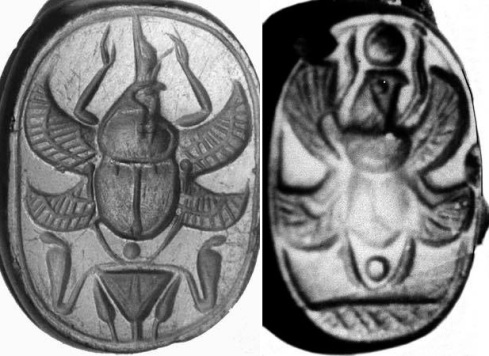
Fig. 46: Horus in the form of a scarab.
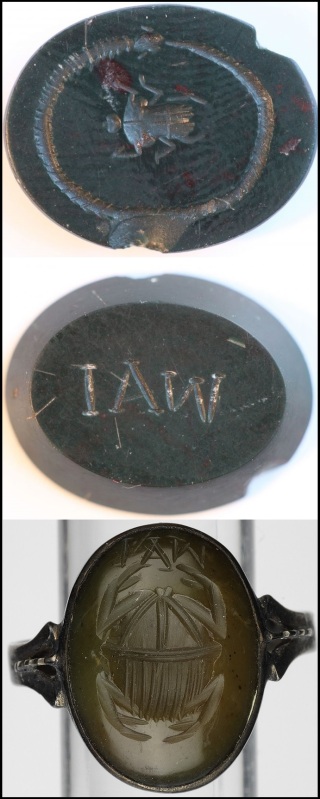
Fig. 47: YHW/IAΩ in the form of a scarab.
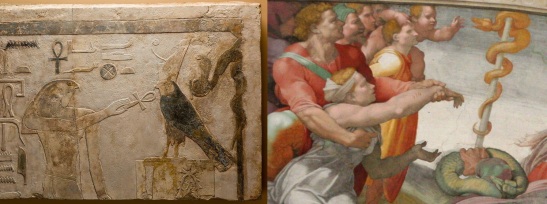
Fig. 48: Left- Horus restores life to the pharaoh via a serpent upon a staff; relief block from a building of Amenemhat I, c. 1981-1952 BCE, currently at the Metropolitan Museum of Art. Right- YHW/IAΩ restores life via a serpent upon a staff, allegedly 1300-1200 BCE.

Fig. 49: Left- the ark of YHW/IAΩ. Right- the ark of Horus, from the temple of Seti I in Abydos, 13th cen. BCE.
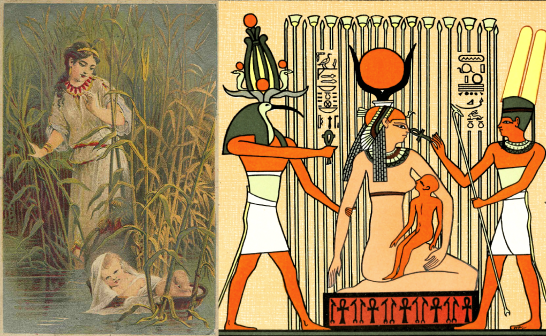
Fig. 50: Left- YHW/IAΩ hides his chosen child from the king of Egypt in the bulrushes of the Nile. Right- Isis hides the chosen child Horus from the king of Egypt in the bulrushes of the Nile at Chemmis. “Your mother Isis has borne you in Chemmis.” -Pyramid Texts, Utterance 609 § 1703. “You are pregnant and you are hidden, girl! You will give birth, being pregnant for the gods, seeing that(?) he is the seed of Osiris. May that villain who slew his father not come, lest he break the egg in its early stages.” -Coffin Texts, Spell 148 II, 217. “I hid me in the bulrushes to conceal thy son in order to avenge thee, Because it is a very evil state of affairs, the being far from thee, And it is not fitting for thy flesh. I walk alone, wandering in the bulrushes, And many (?) are enraged against thy son.” –Bremner-Rhind Papyrus, Songs of Isis and Nephthys § 7.13-18.
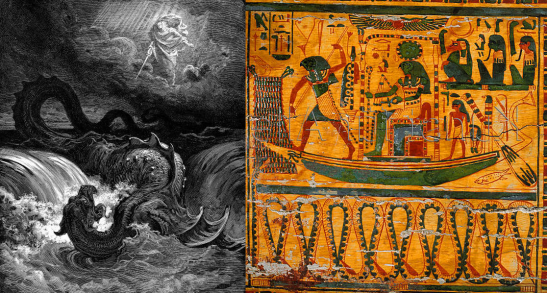
Fig. 51: Left- YHW/IAΩ defeats his adversary, the sea serpent Leviathan. Right- Horus defeats the adversary of Re, the sea serpent Apophis; from the coffin of Nespawershepi, 10th cen. BCE.
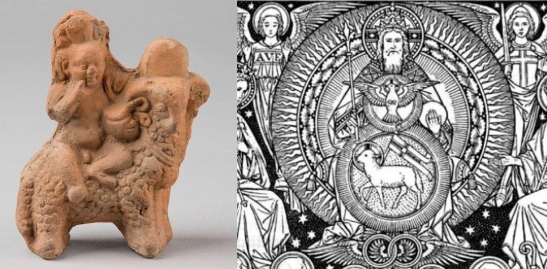
Fig. 52: Left- Horus with his pet lamb. Right- YHW/IAΩ with his pet lamb.
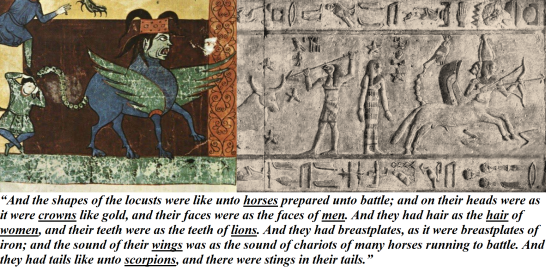
Fig. 53: Left- the apocalyptic locusts of YHW/IAΩ. Right- Sagittarius guards Horus as he battles Seth in the form of a bull.
Another such conflation took place between the Graeco-Syrian god Adonis and the Levantine god Adonai.
And don’t forget the shrine of Adonis, Venus wept for,
and the sacred Sabbath rites of the Syrian J**s.Ovid, Ars Amatoria 1.3.75-76 (1st cen. BCE) [53]
What God is Worshipped by the J**s- Here Symmachus, greatly wondering at what was spoken, says: “What, Lamprias, will you permit our tutelar god, called Evius, the inciter of women, famous for the honors he has conferred upon him by madmen, to be inscribed and enrolled in the mysteries of the J**s? Or is there any solid reason that can be given to prove Adonis to be the same?”
Plutarch, Moralia, 671B-C [54]
And of course, as mentioned early in this article, these Levantine gods Adonai, Eloh, and YHW/IAΩ, etc., though originally distinct (“YHW said unto Adonai, sit thou at my right hand, until I make thine enemies thy footstool” and “The chariots of Eloh are twenty thousand, even thousands of angels: Adonai is among them”) were all conflated with each other just as they were conflated with Adonis, Dionysus, Osiris, and Horus before the Common Era. E.g.:
“Thrice in the year shall all your men children appear before Adonai Yhw Eloh’m.”
“Therefore Adonai Yhw Eloh Sabaoth saith thus- Wailing shall be in all streets; and they shall say in all the highways, Alas! alas!”
“For Yhw is Eloh’m and Adonai, a great El, a mighty, and a terrible, which regardeth not persons, nor taketh reward.”
So for centuries prior to the Common Era these Levantine gods were heavily engaged in syncretism with other gods. First they assimilated with each other into one god, then through cultural exchange with the gentiles, they assimilated with popular “mystery cult” gods such as Osiris, Dionysus, Adonis, and Horus, based on a handful of initial similarities, which over time accrued into some conspicuous parallels through this mutual cultural exchange. But of all these similarities which “Adonai Yhw Eloh” shared with these pagan gods, he appears to have still lacked the most significant mythological motif which Osiris, Dionysus, Adonis, and Horus all had in common. That motif being a death and bodily resurrection. Sure, through this well established pre-Common Era syncretism the motif could be extrapolated over to Adonai-Yhw-Eloh via interpretatio graeca-romana, but his indigenous scriptures and mythos lacked an explicit death and resurrection narrative of his own. Whatever was he to do?
Enter: the Good Shepherd.
“And when he had opened the book, he found the place where it was written, The Spirit of Adonai is upon me, because Yhw hath anointed me to preach the gospel to the poor.”
“I and my Father are one. … Thou, being a man, makest thyself God.”
“He that hath seen me hath seen the Father … I am in the Father, and the Father in me.”
“Eloh, Eloh, lama sabachthani.”
“He answered and said unto him, My Lord and my God.”
“Let this mind be in you, which was also in Him: Who, being in the form of God, thought it not robbery to be equal with God.”
“For in him dwelleth all the fulness of the Godhead bodily.”
“I am Alpha and Omega, the beginning and the ending, saith the Lord, which is, and which was, and which is to come, the Almighty.”

Fig. 54: “For there are three that bear record in heaven, the Father, the Word, and the Holy Ghost: and these three are one.”
By establishing himself not only as son of, but also a consubstantial hypostasis of, his alleged father Adonai-Yhw/IAΩ-Eloh—a form of this god in human flesh—then through his own death and bodily resurrection, the Good Shepherd thus introduced a bona fide death & resurrection narrative into the mythos of Adonai-Yhw-Eloh. Finally this god was on par with his peers, his fellow dying & rising gods with whom he was conflated before Good Shepherd ever came along.
And because of that long standing syncretism, by identifying himself as a human form of Adonai-Yhw-Eloh, Good Shepherd by default added himself into that mix of syncretic deities and by extension identified himself with them as soon as he identified himself with his father.
Through his identification with Yhw/IAΩ, Good Shepherd became identified with Horus as well, just as Yhw/IAΩ already was.
In the centre of the upper half stands a naked four-winged figure in frontal view, with halo, lion masks on his knees, holding two scorpions in each hand and treading two crocodiles under his feet–the familiar ‘Horus on the crocodiles’ of ancient Egyptian magic. … This figure is meant to be no other than [Good Shepherd] Himself. … The second character in the line above the Greek inscription (left of the crocodiles) appears to be a monogram of [Good Shepherd]: … We have [Good Shepherd] shown in the shape of Horus.
Dr. Alfons A. Barb, in Journal of the Warburg and Courtauld Institutes [55]
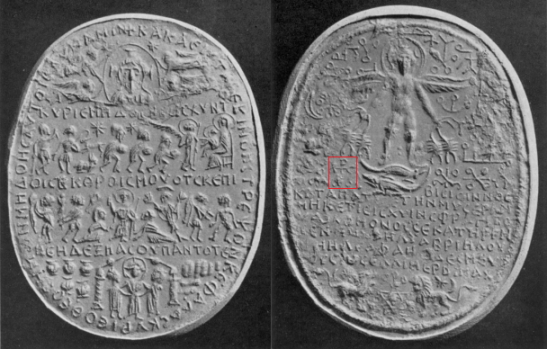
Fig. 55: Left- scenes from the life of the Good Shepherd. Right- on the reverse side, Good Shepherd (identified by his monogram on the left) in the form of the four-winged Horus (cf. Figure 42 above) in his traditional pose standing upon the crocodiles while holding scorpions and snakes; Gnostic amulet, currently at the British Museum.
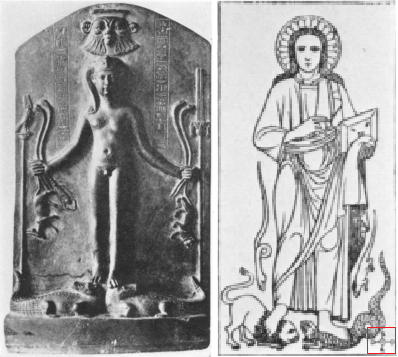
Fig. 56: Left- Cippus of Horus from Cairo, portraying him in his iconic pose standing upon the crocodiles while holding snakes and scorpions, etc. Right- replication of a lost wall painting of the Good Shepherd from Alexandria.[56]
As another example of assimilation between Horus and [Good Shepherd] may be cited a bas-relief on the wall of an early Egyptian church belonging to the Memnonium at Abydos. In it [Good Shepherd] is portrayed sitting on his throne with the horned disk of Horus and holding a modification of the staff or crook of Osiris. In the theology and art of Gnosticism Horus and [Good Shepherd] could easily be blended.
Dr. Reginald E. Witt, Isis in the Ancient World [57]
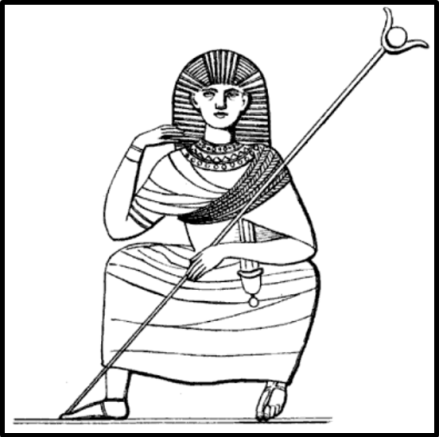
Fig. 57: The Good Shepherd as Horus; based on a bas-relief from the Memnonium church of Abydos, Roman Imperial Era.

Fig. 58: The winged sun disk of Horus flanked by seraphim donning the crowns of Osiris and Isis.[58]

Fig. 59: A “Romanized” sun disk of Horus, on which the cross of the Good Shepherd has been carved over it, thus syncretizing these two gods.[59]
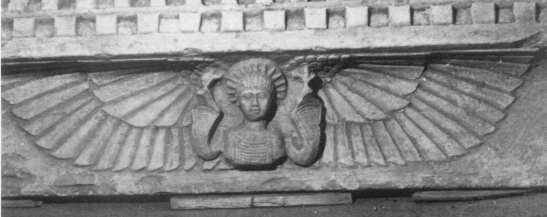
Fig. 60: The Good Shepherd as the winged sun disk of Horus, flanked by seraphim donning the crowns of Osiris and Isis; from the antiquities of K. Hamouda in Cairo.[60] “The Sun of righteousness shall arise with healing in his wings.”
O holy of holies, unshakable, indestructible rock! Child of the maiden, firstborn of your father and mother! Ⲓⲏⲥⲟⲩⲥ our lord came walking upon the Mount of Olives in the midst of his twelve apostles, and he found a doe […] in pain […] in labor pains. It spoke to him in these words: “Greetings, child of the maiden! Greetings, firstborn of your father and mother! You must come and help me in this time of need.” He rolled his eyes and said, “You are not able to tolerate my glory, nor to tolerate that of my twelve apostles. But though I flee, Michael the archangel will come to you with his wand in his hand and receive an offering of wine. And he will invoke my name down upon it with the name of the apostles, for whatever is crooked, let it be straight: Let the baby come to the light!” The will of my heart happens quickly. It is I who speak, the lord Ⲓⲏⲥⲟⲩⲥ. The gift […]. Ⲓⲏⲥⲟⲩⲥ Horus the son of Isis went upon a mountain in order to rest. He performed his music, set his nets, and captured a falcon, a Bank bird, a wild pelican. He cut it without a knife, cooked it without fire, and ate it without salt on it. He had pain, and the area around his navel hurt him, and he wept with loud weeping, saying, “Today I am bringing my mother Isis to me. I want a demon so that I may send him to my mother Isis.” The first demon Agrippas came to him and said to him, “you want to go to your mother Isis?” He said, “How long will it take for you to go there and how long for you to come back?” He said, “How long will it take for you to go there and how long for you to come back? I can go there in two hours and I can come back in two.” He said, “Leave, you do not satisfy me.” The second demon Agrippas came to him and said, “you want to go to your mother Isis?” He said, “How much time do you need to go there and how much time to come back?” He said, “I can go there in one hour and I can come back in one.” He said, “Leave, you do not satisfy me.” The third demon Agrippas, the one with a single eye and a single hand, came to him and said to him, “Do you want to go to your mother Isis?”
“How long will it take for you to go there and how long for you to come back?”
“I can go there with the breath of your mouth and I can come back with the breath of your nose.”
“Go then, you satisfy me.”
He went upon the mountain of Heliopolis and found his mother Isis wearing an iron crown and stoking a copper oven. She said to him, “Demon Agrippas, from where have you come to this place?” He said to her, “Your son Horus went upon a mountain in order to rest. He performed his music, set his nets, and captured a falcon, a Bank bird, a wild pelican. He cut it without a knife, cooked it without fire, and ate it without salt on it. He had pain, and the area around his navel hurt him.” She said to him, “Even if you did not find me and did not find my name, the true name that the sun bears to the west and the moon bears to the east and that is borne by the six propitiatory stars under the sun, you would summon the three hundred vessels that are around the navel: Let every sickness and every difficulty and every pain that is in the belly of __ child of __ stop at this moment. I am the one who calls; the lord Ⲓⲏⲥⲟⲩⲥ is the one who grants healing.”Papyrus Berlin 8313 [61]
Through his identification with Eloh, Good Shepherd thus became syncretized with Osiris/Serapis, just as his father Eloh already was.
From Hadrian Augustus to Servianus the consul, greeting. The land of Egypt, the praises of which you have been recounting to me, my dear Servianus, I have found to be wholly light-minded, unstable, and blown about by every breath of rumour. There those who worship Serapis are, in fact, [Good Shepherd’s followers], and those who call themselves bishops of [Good Shepherd] are, in fact, devotees of Serapis.
Historia Augusta 29.8.2-3 [62]
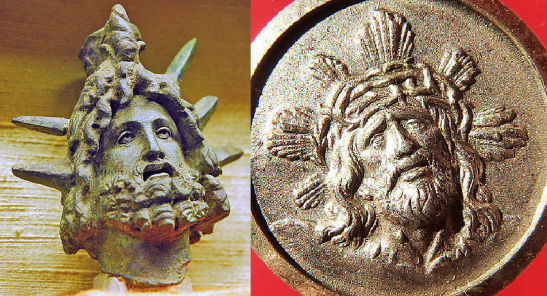
Fig. 61: Left- bronze head of Serapis donning his solar crown of thorns; Ptolemaic Era, currently at the Museum of Montmaurin. Right- Jim Caviezel (or perhaps Robert Powell or Ted Neeley) likewise donning a solar crown of thorns.
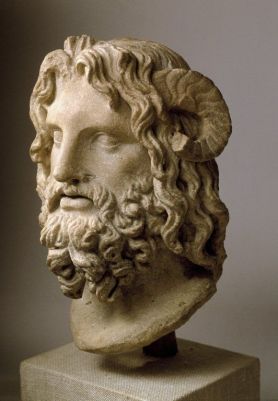
Fig. 62: The lamb of God, a.k.a. Serapis/Osiris; Roman marble bust, 1st cen. CE, currently at the Brooklyn Museum.
Thoth gave Isis knowledge how to realize the resurrection of her son Osiris, which served as a model for the later myth of [Good Shepherd’s] resurrection.
Dr. Willis Barnstone, in The Gnostic Bible [63]
Through his identification with Adonai, Good Shepherd thus became syncretized with the Graeco-Syrian god Adonis as well, just as Adonai and Osiris already were.
Even my own Beth****m, as it now is, that most venerable spot in the whole world of which the psalmist sings:
the truth has sprung out of the earth,was overshadowed by a grove of Tammuz, that is of Adonis; and in the very cave where the infant [Good Shepherd] had uttered His earliest cry lamentation was made for the paramour of Venus.Jerome of Stridon, Epistle to Paulinus 58.3 [64]
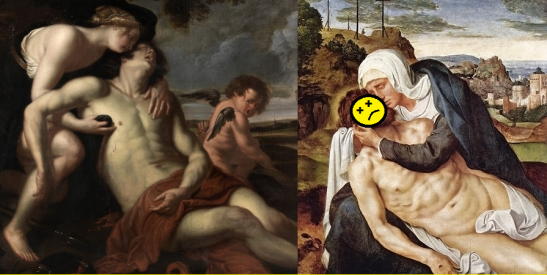
Fig. 63: Adonis is mourned by Venus prior to his resurrection, just as Good Shepherd is mourned by his mother prior to his own resurrection.
Now as for Dionysus, while I’m not aware of any explicit conflation of Good Shepherd with Dionysus himself as his father Eloh was, it is interesting that Good Shepherd was unambiguously conflated with the epic hero Orpheus, who legend has it was the founder and high priest of the mystery cult of Dionysus and thus emulated Dionysus’ death & resurrection.
Orpheus, because he was the leader of the rites of Dionysos, is said to have suffered the like fate to his god.
Proclus, Commentary on Plato’s Republic
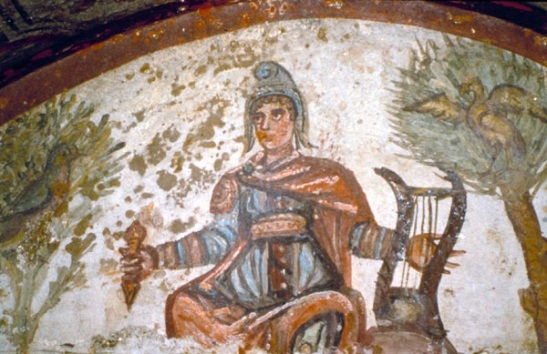
Fig. 64: The Good Shepherd portrayed as the legendary Orpheus, the original high priest of Dionysus; from the catacombs of Peter and Marcellus in Rome.
But it doesn’t stop there, as early as his own lifetime Good Shepherd was conflated with the Graeco/Roman/Mithraic god known as Sol or Helios.
“He was transfigured before them: and his face did shine as Helios, and his raiment was white as the light.”
“But unto you that fear my name shall the righteous Helios arise with healing in his wings.” (LXX version, the one Good Shepherd used.)
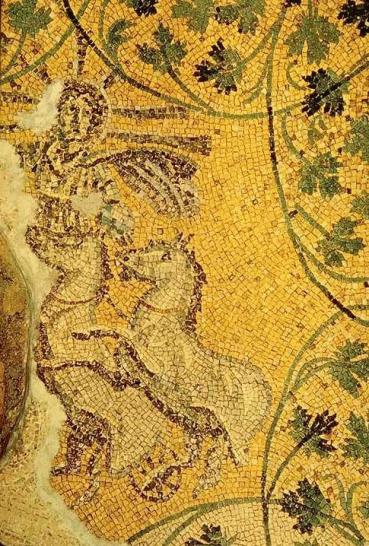
Fig. 65: The Good Shepherd as Helios/Sol Invictus driving the solar chariot through the heavens; from the tomb of Julii in Rome, 3rd cen.
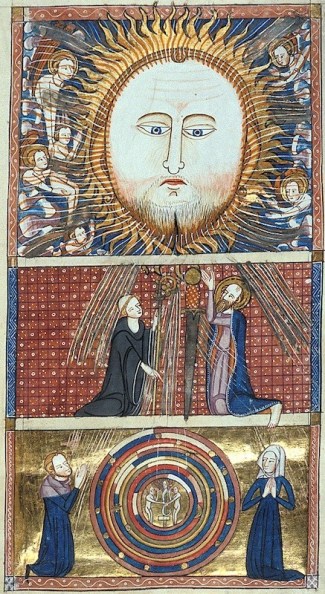
Fig. 66: Good Shepherd being worshiped in the form of Helios/Sol.
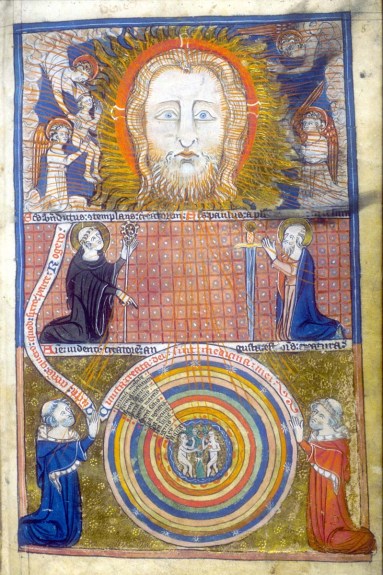
Fig. 67: “Every good gift and every perfect gift is from above, and cometh down from the Father of lights.”
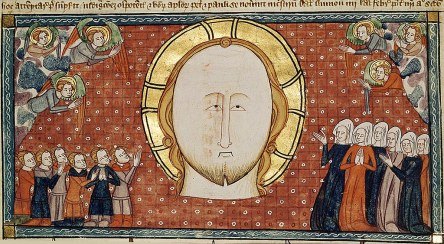
Fig. 68: “I am the light of the world: he that followeth me shall not walk in darkness, but shall have the light of life.”
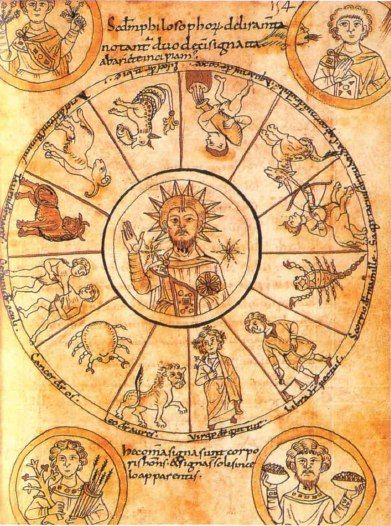
Fig. 69: Good Shepherd yet again in the form of Helios/Sol Invictus, this time in the center of the four seasons within the wheel of the zodiac.
So when we “mythicists” make comparisons between the Good Shepherd’s mythos and those of gods like Osiris, Horus, Dionysus, Adonis, Sol Invictus, etc., we are not selecting these gods just arbitrarily in some desperate attempt to “debunk” the Good Shepherd’s religion. Instead, we select these particular gods because the Good Shepherd was already conflated with these gods for millennia, very early on in his religion’s history. And even more to the point- his father was already intimately conflated with these particular gods for centuries prior to Good Shepherd’s birth, and not just by the heathen gentiles, but his own ancestors in his own homeland made these conflations as well. Thus when Good Shepherd finally shows up on the scene with a mythos containing archetypes very similar to those of this particular group of gods that his father was syncretized with, we have good reason to suspect that there was some influence there.
Now in synopsis, and to put this into some perspective:

The Good Shepherd and his religion were born out of a culture that was a massive whirlpool of syncretism that had been going on consistently for centuries, where everyone was playing Mr. Potato Head with the various religions & mythologies of the world (including his father Adonai-Eloh-Yhw) of which Good Shepherd himself was but another unexceptional Potato Head to play with every bit as much as other “hodge podge” gods which originated and/or were popularized at that same time from that same syncretic culture such as Mithras, Sabazios, Dolichenus, Phanes, Abraxas, etc..

He was not immune to this, he originated out of this, he was a product of it, there was nothing to make him stand apart from it, and at no time was he ever distinct from it. To regard him as special from it is to engage in special pleading. Six of one, half dozen of another.
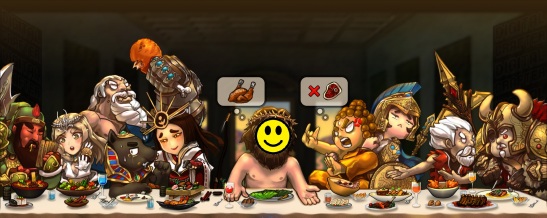
Notes
[1] Herodotus, Histories, in The Landmark Herodotus: The Histories, ed. R.B. Strassler, trans. A.L. Purvis (New York: Anchor Books, 2009), 136, 172, 185, 192. (Emph. added.)
[2] Cicero, The Nature of the Gods, trans. P.G. Walsh (Oxford: Oxford University Press, 1998), 128. (Emph. added.)
[3] Diodorus of Sicily, Library of History, in Diodorus Siculus: Library of History, Books 1-2.34, trans. C.H. Oldfather (London: William Heinemann Ltd., and Cambridge, Mass.: Harvard University Press, 1933-67), 39, 51, 57, 327.
[4] Plutarch, Moralia, in Plutarch’s Moralia: Volume V, trans. F.C. Babbitt, (London: William Heinemann Ltd., and Cambridge, Mass.: Harvard University Press, 1936-62), 35, 69, 83, 85.
[5] Left: Bust depicting Osiris transforming into Apis and emerging from a lotus flower; from the Serapaeum of the Canope in Hadrian’s Villa, currently at the Vatican’s Gregorian Egyptian Museum.
Right: Bronze mask of the horned Dionysus, 200-100 BCE, currently at the British Museum in London.
[6] Left: livewithoutdeadtime.wordpress.com/2012/04/10/the-grief-of-isis/.
Right: The Infant Bacchus Killed by the Titans and Restored to Life by Rhea by Taddeo Zuccaro.
[7] Joseph D. Reed, “The Death of Osiris in ‘Aeneis’,” in The American Journal of Philology 119, no. 3 (1998): 411.
[8] Willis Barnstone and Marvin Meyer, The Gnostic Bible (Boston: New Seeds Books, 2003), 483-84.
[9] Lucian of Samosata, On the Syrian Goddess, trans. J.L. Lightfoot (Oxford: Oxford University Press, 2003), 251-53.
[10] Lamprias, Symmachus, and Moeragenes, in Plutarch’s Moralia: Volume VIII, trans. P.A. Clement and H.B. Hoffleit (London: William Heinemann Ltd., and Cambridge, Mass.: Harvard University Press, 1969), 359-61. (Emph. added.)
[11] Barnstone and Meyer (2003), 483-84. (Emph. added.) See also p.677, n.1967.
[12] Maarten J. Vermaseren, Corpus Cultus Cybelae Attidisque (CCCA) VI: Germania, Raetia, Noricum, Pannonia, Dalmatia, Macedonia, Thracia, Moesia, Dacia, Regnum Bospori, Colchis, Scythia et Sarmatia (Leiden: E.J. Brill, 1989), 121. (Emph. added.)
[13] Clement of Alexandria, Exhortation to the Heathen, in The Ante-Nicene Fathers: Volume II, eds. A. Roberts and J. Donaldson, trans. A. Roberts (Peabody: Hendrickson Publishers, 1885-1994), 176.
[14] Plutarch, Lives: Sertorius, in Plutarch’s Lives: Volume VIII, trans. B. Perrin (London: William Heinemann Ltd., and Cambridge, Mass.: Harvard University Press, 1919-59), 3. (Emph. added.)
[15] Statius, Thebaid, in Statius: Thebaid, Books 1-7, trans. D.R.S. Bailey (Cambridge, Mass: Harvard University Press, 2003), 93. (Emph. added.)
[16] Manfred Clauss, The Roman Cult of Mithras: The God and His Mysteries, trans. R.L. Gordon (New York: Routledge, 1990-2001), 156-57. (Emph. added.)
[17] Sergej Ju. Saprykin, “The Religion and Cults of the Pontic Kingdom: Political Aspects,” in Mithridates VI and The Pontic Kingdom, ed. J.M. Højte (Århus: Aarhus University Press, 2009), 249. (Emph. added.)
[18] Pia G. Bilde et al., Archaeology in the Black Sea Region in Classical Antiquity 1993-2007 (Athens: The Council of the Society for the Promotion of Hellenic Studies & Council of the British School at Athens, 2008), 146-47. (Emph. added.)
[19] Ausonius of Burdigala, Epigram XLVIII, in Ausionius: Volume II, trans. H.G. Evelyn White (London: William Heinemann, 1921), 187.
[20] David Flusser and Shua Amorai-Stark, “The Goddess Thermuthis,” in J**ish Studies Quarterly, Vol 1. (1994): 217.
[21] Gerard Mussies, in Studies in Egyptian Religion: Dedicated to Professor Jan Zandee, eds. M. Heerma Van Voss, D.J. Hoens, G. Mussies, D. Van Der Plas, H. Te Velde (Leiden: E.J. Brill, 1982), 90-91.
[22] https://web.archive.org/web/20180408074943/http://cfvod.kaltura.com/pd/p/618072/sp/61807200/serveFlavor/entryId/1_0syfuehq/v/1/flavorId/1_k0ntgecf/name/a.mp3.
[23] Carolyn R. Higginbotham, Egyptianization and Elite Emulation in Ramesside ****stine: Governance and Accomodation on the Imperial Periphery (Leiden: Koninklijke Brill NV, 2000), 71, 126.
[24] Anthony Spalinger, “The army,” in The Egyptian World, T.A. H. Wilkinson,(Abingdon: Routledge, 2007), 122.
[25] Walter E. Rast, Through the Ages in ****stinian Archaeology: An Introductory Handbook (Philadelphia: Trinity Press International, 1992.), 161. (Emph. added.)
[26] Johannes G. de Casparis et al., “Ideologies and the First Universal Religions,” in History of Humanity: From the Seventh Century B.C. to the Seventh Century A.D., eds. J. Herrmann and E. Zürcher (London: Routledge, 1996), 58.
[27] Spalinger (2007), 123.
[28] Higginbotham (2000), 2.
[29] Rast (1992), 94.
[30] Yeleazar Meletinsky, The Poetics of Myth, trans. G. Lanoue and A. Sadetsky (New York: Routledge, 1998-2000), 308.
[31] Gerard Mussies, “The Interpretatio Judaica of Sarapis,” in Studies in Hellenistic Religions, ed. M.J. Vermaseren (Leiden: E.J. Brill, 1979), 193, 209, 214. (Emph. added.)
[32] Ulmer (2009), 12.
[33] George R.H. Wright, As On the First Day: Essays in Religious Constants (Leiden: E.J. Brill, 1987), 76-77.
[34] https://bit.ly/32zcMLx.
[35] Gregory D. Mumford, “Egypt and the Levant,” in The Oxford Handbook of the Archaeology of the Levant c. 8000-332 BCE, eds. M.L. Steiner, A.E. Killebrew (Oxford: Oxford University Press, 2013), 78.
[36] Maurice Sartre, The Middle East Under Rome (Cambridge: Harvard University Press, 2005), 303-4. (Emph. added.)
[37] Barry Blackburn, Theios Anēr and the Markan Miracle Tradition (Tübingen: J.C.B. Mohr, 1991), 231. (Emph. added.)
[38] Laurent Bricault, “Deities from Egypt on Coins of Southern Levant,” in Israel Numismatic Research 1 (2006): 127, 130. (Emph. added.)
[39] R.A. Stewart Macalister, “Second Quarterly Report on the Excavation of Gezer,” in P*******e Exploration Fund (1903): 37.
[40] Lawrence E. Stager, J. David Schloen, Daniel M. Master, Michael D. Press, and Adam Aja, “The South Tell: Grid 38,” in The Leon Levy Expedition to Ashkelon: Ashkelon 1, Introduction and Overview (1985-2006), eds. L.E. Stager, J.D. Schloen, D.M. Master (Winona Lake: Eisenbrauns, 2008), 281-82.
[41] Raphael Ventura, “Four Egyptian Funerary Stelae from Deir el-Balaḥ,” in IEJ 37, no. 2/3 (1987): 113.
[42] Trude Dothan, “Cultural Crossroads: Deir el-Balah and the cosmopolitan culture of the Late Bronze Age,” in Biblical Archaeology Review 24.5 (September/October, 1998): 33.
[43] https://www.imj.org.il/en/collections/365076.
https://www.imj.org.il/en/collections/365204.
https://www.imj.org.il/en/collections/365187.
[44] Dothan (1998), 31.
[45] Plutarch, in Clement and Hoffleit (1969), 363-67. (Emph. added.)
[46] Pliny the Elder, Natural History, in Pliny: Natural History, Books 3-7, trans. H. Rackham, (London: William Heinemann Ltd., and Cambridge, Mass.: Harvard University Press, 1942-67), 277.
[47] David Flusser, “Paganism in P*******e,” in Historical Geography, Political History, Social, Cultural and Religious Life and Institutions: Volume Two, eds. S. Safrai, M. Stern (Assen: Van Gorcum, 1976), 1067.
[48] Their own scriptures affirm as much- [link].
See also Diodorus of Sicily, Library of History 1.94.2.
Marcus Terentius Varro, in De Mensibus 4.53.
Irenaeus of Lyons, Against Heresies 1.21.3
Tertullian of Carthage, Adversus Valentinianos 24.3.
Origen Adamantius, Contra Celsum 6.32.
[49] Stephen C. Russell, Images of Egypt in Early Biblical Literature (Berlin: Walter de Gruyter, 2009), 44.
[50] Klaus Koch, “Konigspsalmen und ihr Ritueller Hintergrund,” in The Book of Psalms: Composition and Reception, eds. P.W. Flint, P.D. Miller (Leiden: Koninklijke Brill NV, 2005), 35-37.
John Goldinggay, Psalms: Volume 1 (Grand Rapids: Baker Academic, 2006), 302.
Mark S. Smith, The Early History of God (Grand Rapids: William B. Eerdmans Publishing Co., 1990-2002), 84.
Russell (2009), 44-45.
[51] Abd M. El-Khachab, “Some Gem-Amulets Depicting Harpocrates Seated on a Lotus Flower: To the Memory of My Great Friend Dr. Alexandre Piankoff,” in The Journal of Egyptian Archaeology 57 (1971): 137, 145.
[52] Joachim Śliwa,”Artifact: A pagan palindrome shows how old beliefs die hard,” in Archaeology (May/June, 2015): 72. https://archive.org/details/Archaeology_Magazine_May-June_2015.05-06/page/n73.
[53] https://www.poetryintranslation.com/PITBR/Latin/AmoresBkI.php.
[54] Plutarch, Moralia, in Plutarch’s Lives and Writings: Volume Three, eds. A.H. Clough, W.W. Goodwin (Boston: Little, Brown, and Company, 1909), 310.
[55] Alfons A. Barb, “Three Elusive Amulets,” in Journal of the Warburg and Courtauld Institutes 27 (1964): 13-15.
[56] Ibid.
[57] Reginald E. Witt, Isis in the Ancient World (Baltimore: The Johns Hopkins University Press, 1971-97), 218.
[58] A. M. El-Khachab, “Some Gem-Amulets Depicting Harpocrates Seated on a Lotus Flower,” in The Journal of Egyptian Archaeology, Vol. 57 (Aug, 1971): 135.
[59] Ibid. 137.
[60] Ibid. 135.
[61] Marvin Meyer and Richard Smith, “Spells for relieving the pain of childbirth and stomach pain,” in Coptic Texts of Ritual Power, eds. M. Meyer, R. Smith (Princeton: Princeton University Press, 1994), 96-97. (Emph. added.) See also p.361 n.2.1- ” ‘Ⲓⲏⲥⲟⲩⲥ! Horus’: or, ‘Ⲓⲏⲥⲟⲩⲥ Horus.’ In this connection it may be noted that in the Coptic Museum in Old Cairo there is a wooden crucifix with the crucified figure of Ⲓⲏⲥⲟⲩⲥ together with a falcon (Horus).”
[62] David Magie, Historia Augusta: Volume III (Cambridge: Harvard University Press, 1932-98), 399.
[63] Willis Barnstone, “Hermetic Literature: Introduction,” in The Gnostic Bible, eds. W. Barnstone and M. Meyer (Boston: New Seeds Books, 2003), 497. (Emph. added.)
[64] http://www.newadvent.org/fathers/3001058.htm.

 Aeon Byte Gnostic Radio & Blog
Aeon Byte Gnostic Radio & Blog ATHEOLOGICA: Subjecting Religion to Critical Thought
ATHEOLOGICA: Subjecting Religion to Critical Thought ATHEOMEDY: The Sacrilegious Rants of a Godless Bastard
ATHEOMEDY: The Sacrilegious Rants of a Godless Bastard Hume’s Apprentice
Hume’s Apprentice James Hiscox Blogs
James Hiscox Blogs Michael Sherlock
Michael Sherlock Mythinformed
Mythinformed
Truly extraordinary, groundbreaking stuff here mate. You are tearing down vast fields of mainstream and religious apologetics/pseudo-scholarship. Spread the word throughout the lands!
Pingback: He Shall Save His People From Their Sins: An “Evidentiary Analysis” of Osirian Soteriology | Mythicism.Net
Pingback: In Winter Shall it Be: The Solar Horus Xmas Special, Part 1 | Mythicism.Net
Pingback: I am like a Green Fir Tree: The Solar Horus X-mas Special, Part 2 | Mythicism.Net
Pingback: That Which is Conceived in Her is of the Holy “Spirit”: The Solar Horus X-mas Special, Part 5 | Mythicism.Net
Pingback: I and my Father are One: The Solar Horus X-mas Special, Part 6 | Mythicism.Net
“The Jews call Osair the Son of God, and the Christians call Christ the Son of God. That is a saying from their mouth; in this they but imitate what the unbelievers of old used to say. Allah’s curse be on them: how they are deluded away from the Truth!”- Quran, Surah At-Tawbah 9:30.
“The name Uzair here is a derivative of the Pharaohs god Osiris.”
Pingback: The Virgin Birth of Osiris | Mythicism.Net
A fascinating timeline! The introduction of Osiris outside Egypt may also relate to the early popularity of Hathor. Scaraboids and amulets from Canaan show that her theme, the squared falcon, is already popular in the Middle Bronze Age. In the Phoenician and Punic era the ‘Eye of Horus’ is the most popular scaraboid. About 85 to 90% of all Phoenician scarabs and amulets have some form of Egyptianized iconography. And most of these scarabs depict themes or (helper) deities that relate to Osiris, Isis-Hathor and Horus.
This early introduction of Hathor in the Levant boosted the blending of multiple traditions as with her arrival different versions of Horus appeared like The Elder, The Younger, the Savior, the Avenger, the Child, Horus in the Horizon etc. As Hathor blended with Semitic goddess Astarte any male deity that accompanied her in Phoenicia her is most likely a manifestation of Horus. Adonis matches with Horus/Lhy, the form dedicated to music, dance, festivities and drunkenness. Eshmun of Sidon matches with Horus the Savior and MLQRT of Tyre matches with Horus the Younger or Semitic ‘MLQ QRT’, the ‘King of the Earth’. A nice example of this syncretism is provided by a Cippi from Malta with its dedicatory multilingual inscription to Melqart. The Greek inscription names Dionýsios and the Semitic one Osiris.
This model can help explain the blending of multiple traditions. The role of Hathor-Isis is perhaps crucial as recent excavations provide more and more evidence for her prominent status outside Egypt – from northern Spain to the Neo-Assyrian empire – in the late 2nd millennium BCE.